#west japan sectionals
Text


2023 West Japan Sectionals - October 28, 2023
Mako Yamashita → Music from “Baragaki: Unbroken Samurai” by Reiko Tsuchiya: Habanera of Death, Banquet of Assassins, Scarlet Robe, Battle of Toba-Fushimi
#mako yamashita#figure skating#fs#west japan sectionals#west japan sectionals 2023#season: 2023 2024#this is becoming a series
20 notes
·
View notes
Text
It's interesting how the same misogynistic trope can reappear, independently, in different countries. I'm reading "Scream from the shadows: the women's liberation movement in Japan" and this section about the connotations of the word 'woman' is interesting:
In the Japanese context, the semantic distinctions between the terms fujin, josei, and onna, which are all translated as “women” and/or “woman,” must be given careful attention, as they often signal political differences. Ribu [women's lib] activists deliberately chose and reappropriated onna, a term for woman that can be used in a pejorative manner with sexual or lower-class connotations. As noted by Kano Masanao, the term onna approximated a discriminatory word (sabetsu go). It signified the raw and total being that had to be liberated. According to linguistics scholar Orie Endo, its strong sexual implications made it a term that could “be substituted for many sexually related terms, such as mistress or prostitute,” and this was considered disrespectful, taboo, even “dirty.”
As a kid, I never liked the word 'woman' because it often sounded sexual to me, and I hated the way it was used. "My vices are alcohol, cigarettes, and women" - treating 'women' as equivalent as objects. "Love going to Colombia and seeing all the beautiful women" - treating 'women' as sightseeing objects. "You've known her since she was a girl, now watch her become a woman" - being a 'woman' is to be a passive sex object that is (often against her will) penetrated.
I used to think this was my personal issue with the word, but I've since learned other women also felt the same way about the word. And apparently in Japan, the word we foreigners are taught is the default word for woman (we learn woman = onna and man = otoko) is also subject to being sexualized, objectified, and degraded. What the Japanese 'ribu' activists did was to reclaim the word onna to mean a woman who was a subject, who was free to pursue sexual pleasure for herself and not for men. In other words, the degradation of the word for 'woman' isn't just something that happens in English, but in other languages and cultures. In this case, it does not appear to be a result of Western colonization, either.
If you haven't read much feminist work outside your home country (or about the West), I strongly recommend doing so. The more you learn about feminists in other countries, the more you realize that the form sexism takes is eerily universal.
429 notes
·
View notes
Text
music and narrative {[0]}
so. as part of the ongoing music researches, I've for a while wanted about the relation between music and narrative. that's going to be a long project! but to begin with I wanted to run down the examples I know, and maybe solicit a few more~
now, on some level, nearly any song has some degree of narrative. your basic love song introduces us to some characters - singer, object of their affection - and furnishes them with emotions and desires. moreover, music can play a role in a narrative without literally relating events - indeed, the art of soundtrack design is definitely a subject I want to look into at some point. even songs addressed directly at the real world, such as political songs, construct some kind of narrative.
however, for these purposes, I'm interested in songs that go a bit further in the direction of telling a fictional story, especially when those link together into whole albums (sometimes called a concept album, though this is a slightly broader concept). which can work in a lot of ways!


for example, Janelle Monae's The ArchAndroid tells a sweeping scifi story of an android fleeing an oppressive society and becoming an unintentional figurehead of revolution. it sketches out a wide-reaching set of influences in constructing a scifi world, but you'd be hard-pressed to boil it down into a simple series of events - it prefers to leave a lot to interpretation. by contrast something like Splendor & Misery by clipping. deals with kinda similar subject matter - a scifi story, an escaped slave, artificial intelligence - but with a different musical approach and perhaps a slightly clearer narrative arc; sometimes directly narrating the thoughts and actions of characters, or slipping into memory, but also drawing less direct musical parallels with e.g. gospel tracks and slave spirituals. both excellent albums - both solve the problems of conveying a story musically in different ways.
of course, the largest pool of examples here comes in the context of musical theatre, and further back opera. (the exact transition from one to the other is something I'm going to need to research). particularly interesting to me are sung-through musicals such as Les Misérables, in which there's no spoken sections in between the songs. this restriction means the songs (and staging etc.) have to do all the work of conveying the events of the story.
there's a lot to be said about the various traditions of musicals (for example). there's even more to be said about the history of opera - both the Western traditions and other musical traditions that have been given the label such as Chinese opera. but that will have to wait for later day in the project because otherwise this entire post would be a huge list of musicals, and I want to try and wander all over the shop.
what I'm most curious to find is music that tells a story all on its own - no actors or staging, but more similar to oral narration. of course, in the present era, music is often released along with videos, and these can tell quite elaborate stories that will become part of the overall 'message' communicated by the song, so the lines are a bit blurry! but since the aim of this series will be to look for ways to convey narrative using music, I'm looking for examples where the music does most of the heavy lifting.
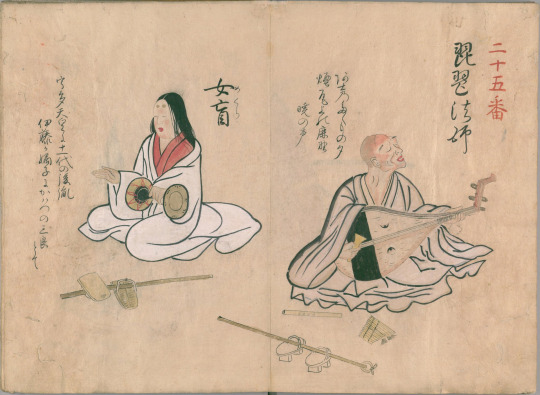
music that tells stories is something with a looong tradition in folk music, pretty much the world over. in Europe, the ballad was a common form for it, a word that survives into the present. it seems that most cultures have had some kind of tradition of wandering itinerant musician-poets - for example, at various points in history, there were biwa hōshi in Japan (pictured) and griots in West Africa, medieval Europeans had minstrels, the Celts had bards, the Occitans had troubadors...
moreover, work and marching songs such as sea shanties would also have a certain degree of narrative to them, in addition to their main function of keeping a group moving in time.
in modern times, people will sometimes attempt to reconstruct how this kind of music and lyric poetry would have been performed. you can naturally only go so far with the archaeological evidence, but I'm fond of Peter Pringle's recordings of segments of the Epic of Gilgamesh, using period instruments if not necessarily a period musical style!
in the modern age of recorded music, these traditions have become much more niche, but there are still artists who use music as a vehicle to tell a fictional narrative. (fair warning: I'm a huge nerd, so most of the examples I know are like, supreme nerd shit. also about ten years ago I was given an assortment of metal from a friend which included a bunch of what I'm about to put below.)


to begin with I've naturally got to talk about my friend Maki Yamazaki (Dr Carmilla) and the band she founded but later left, The Mechanisms. They tell a story of a sprawling gothic scifi universe, with the band playing the role of travelling space pirates who observe the (invariably tragic) tales that unfold. The Mechanisms' music starts as folk song pastiche, but gradually gets more original, although narratively they keep the approach of crossing over mythology with genre storytelling (fairy tales as space opera, arthuriana as space western).
The Mechanisms got a significant measure of international fame washing back after their frontman Johnny Sims got really big on some podcast or something.
Maki's solo music as Dr Carmilla took things in (from a narrative sense) a more abstract direction, using elaborate production and an incredibly textured sound to tell a (so far!) fragmentary story of the tragic space vampire Dr Carmilla and her doomed relationship with another vampire Lorelei (for example). And I'm gonna have lots more to say about them all, in the future, but this is just an overview so let's not get ahead of ourselves!
In a related vein (though I'm much less familiar with them) comes indie band Decemberists, who often create narratively driven songs - for example, The Mariner's Revenge Song depicts a sailor's motivation for extracting bloody revenge on someone who wronged him, with the actual violence conveyed by an energetic instrumental break. A subject that reminds me of the Clockwork Quartet, now long gone, who managed to record just three of their songs from a larger project, yet stand out as way more interesting than most of the steampunk milieu - with for example The Clockmaker's Apprentice giving a very fun antihero-revenge narrative to the ticking beat of a clock, and The Doctor's Wife a compelling tragedy of desperate medical science.


There's definitely something in common with this type of storytelling and the subgenre termed rock opera, which has a pretty long history going back to the late 60s (SF Sorrow by Pretty Things and The Story of Simon Simopath by Nirvana, thanks wikipedia), with notable examples including some incredibly popular albums like Pink Floyd's The Wall (which was adapted into a partly animated film using animations by Gerard Scarfe, c.f AN86) and My Chemical Romance's The Black Parade. In many of these, the connection between songs and narrative is fairly abstract and metaphorical - most of the examples mentioned are about the psychological arc of one character.
Calling this a genre or subgenre is kind of a stretch recently - just in those four examples we see a pretty wide range of musical styles, so it's more like an approach to album writing. Still, for want of a better word, there's definite overlap between this 'genre' and musicals. For example, the history on wikipedia cites The Rocky Horror Picture Show as an example of rock opera, which in my head it's just a musical. (Anyway, exactly the taxonomy of regular opera/libretto, rock opera and musical theatre is not that important anyway, because we want to look at the techniques of all of them!)


A more direct narrative comes in the work of The Protomen, who have the 'no way that would work' premise of creating a huge, dramatic, emotional story based on the plot of the Mega Man games. By putting the focus on the tense relationships of the fought main characters (scientists Light and Wily and robot boys Proto Man and Mega Man), and their sense of rejection and betrayal by the broader society, they somehow pull it off.
Moving gradually in the direction of (progressive) metal, we encounter Ayreon, whose entire career has been telling psychedelic and occult stories of time travel, aliens, warnings projected into the past, out of body experiences, and the history and direction of humanity. I'm not sure if all of their albums fit together into one big story exactly, but certain ideas seem to keep coming up - for example, future societies or aliens sending warnings to humanity to fix our shit before it's too late. In some of their albums (e.g. The Electric Castle) they follow the device of having each member of the band play a character in an ensemble cast, bringing it a bit closer to something like a radio play.
Also in metal land we find the rather unique project Charlemagne: By The Sword and the Cross, best known for that time Christopher Lee shed the blood of the saxon men. This is using music as a vehicle for a (more or less) historical story, featuring an old Charlemagne (Lee) reminiscing on the various awful things he did over the course of his life. Apparently they made a sequel to this album, which I never realised!
As well as history, metal also likes to lean on literature and poetry. For example, Kamelot (classed, apparently, as 'Power Metal') have a rather fun adaptation of the story of Faust into two albums, Epica and The Black Halo. Iron Maiden famously took on the Rime of the Ancient Mariner in a 13 minute song. And that's not even to get into all the songs dealing with Tolkien.


Moving on from metal before we start listing a hundred songs about vikings, it's worth looking more broadly for music about history, since it's a pretty major overlap with fictional storytelling! For example, the Boney M song Rasputin tells an incredibly catchy account of the assassination of Grigori Rasputin. Another rather more charged example comes in Nakam by Daniel Kahn and the Painted Bird, about the unsuccessful paramilitary plot to poison six million Germans as revenge for the Holocaust.
If you go looking, you can find an impressively long list of historical songs compiled by 30 users of lyrics website Genius - though many of these I feel don't really count, since they were describing contemporary events when they were written.
Of course, there is a heavy overlap between this subject and political songs - in many cases the historical subjects are invoked to comment on the present. For example, Wernher von Braun by Tom Lehrer was written at a time when von Braun was leading the US space programme. In many cases, the songs simply invoke a historical event to express a feeling, assuming you already know what happened. Others may recount events more or less directly, before seguing into a verse or two at the end about why it matters now. Most of the songs in this list focus on recent (20th-century) history, sometimes they reach further back - mostly to talk about colonialism.
Historical songs can also be quite oblique. For example, Mili's song Salt, Pepper, Birds and the Thought Police is about the life of Korean poet Yoon Dong-ju, but you wouldn't necessarily know it from the content of the lyrics unless you were already familiar with Yoon's life. More on Mili in a moment - most of their songs are more fictional.
One thing I'm curious about is whether there are examples of more historical fiction in music, which tries to imagine the thoughts and feelings of historical characters... well obviously there's Hamilton, and perhaps that illustrates why there aren't a lot more songs about non-recent history, because the vibes can be off.


Storytelling is still a powerful mechanism even in a contemporary, political song. Take Construção by Chico Buarque - the story it tells is of the pointless death of a construction worker; with the lines ingeniously remixed over the course of the song, this turns into a wider illustration of the ruthlessness of the system that killed him. Its lyrics are absolutely fucking genius, even if you don't speak Portugese.
Speaking of language, most of the examples I've covered so far are in English, since well, that's my native language. It's naturally a little harder to access a story in a language you don't speak, but in these days of subtitles, we kinda can! So for example I can encounter projects like MILGRAM, something of a combination of music project and voting-driven story, in which we are introduced (by character song) to a number of characters facing execution - and then invited to vote on who should die. Heavily illustrated, it is somewhere vaguely in the space between album and straight-up anime.
I mentioned Mili already, but many of their other songs have a strong narrative arc to them, and sketch out the contours of a fictional setting. For example, one of their best-known songs is world.execute(me), which portrays the failure of a bdsm relationship between an AI girl and her creator. Which is relatively grounded by Mili standards - other songs depict for example the relationship of a jiangshi and a mad scientist cooking food, or a witch reanimating a knight with scientific methods to kill on her behalf.
And I think that will suffice for now. But we are of course only scratching the surface - this is by no means supposed to be an exhaustive list but I'm sure there's stuff that I'll be kicking myself for not mentioning. Mostly, however, this is a request for recommendations - particularly, of music from genres I haven't addressed in this post, and especially non-English languages, or that convey their stories in especially creative or unusual ways.
This project will likely be a long time in the works - it's something of a supplement to the Music Theory Notes (for science bitches) series - but my aim will be to pick out a few of these to examine how they go about conveying narrative through songs. Because I think that's kind of one of the big things I want to do with music.
ok canmom out i gotta go play some music. see you next time!
#music notes#music#canmom vs music#the mechanisms#dr carmilla#the decemberists#the clockwork quartet#pretty things#nirvana#pink floyd#mcr#the protomen#ayreon#kamelot#iron maiden#christopher lee#boney m#daniel kahn#tom lehrer#mili#chico buarque#milgram#i think that's all the bands i mentioned in passing...
78 notes
·
View notes
Text
「Ranpo, Mushi, Seishi」 – Tales from the Burgeoning World of Japanese Mystery
After re-reading Bungou Stray Dogs and with better understanding of the history behind the figures of Japanese Literature, I find myself falling further in love with the Perfect Crime Arc of the BSD Manga.

In a span of three chapters, Mushitarou went from an unknown to one of my favorite mystery authors out there. An outcast of the detective novel world often disregarded due to his pedantic and frankly bizarre way of writing his stories.
Further reading about his life made me realize that this arc is a complete recreation of a section of Mushitarou's life, the other authors he interacted within his short career and an everlasting impact between giants of the Early-Showa Detective Novel scene. It is shocking how Asagiri and Harukawa conceals and works with the details of the story so well, blending in so many different parts of his life into the manga.
The Lineup
To get a better feel of who the three main figures are in this story, I must first introduce the three main authors of this story.



Edogawa Ranpo (left), Oguri Mushitarou (center), Yokomizo Seishi (right)
Edogawa Ranpo (江戸川乱歩, 1894 –1965) was a detective novelist who made a name with his many detective novels which made him a key part of the mystery novel landscape even up to the modern day. He is most well known for creating the character of Akechi Kogorou who first appeared in The Murder on D Hill (D坂の殺人事件) and would later star in many of his novels.
Oguri Mushitarou (小栗虫太郎, 1901 - 1946) was a detective novelist who was known for his bizarre writing style. His use of difficult kanji along with furigana guides for many of his stories makes his works some of the most difficult works to read in Japanese. His most well known work is The Black Death Mansion Murders (黒死館殺人事件) along with the detective Horimizu Rintarou.
Yokomizo Seishi (横溝正史, 1902 - 1981) was a detective novelist who was a master of the 'honkaku' mystery genre. His work The Honjin Murders (本陣殺人事件) and detective Kosuke Kindaichi continue to be a staple of modern Japanese pop culture.
The Making of a Genre

Misery (無惨) by Kuroiwa Ruikou (黒岩涙香) is oft regarded as the first Japanese mystery novels which brought the genre into the public consciousness. A simple murder mystery tale of gambling seemingly gone awry. From this spark then came numerous authors such as Morishita Uson (森下雨村), Ooshita Udaru (大下宇陀児), Hamao Shirou (濱尾四郎) and an up and coming author named Edogawa Ranpo.
Ranpo made a name for himself with the publication of The Two-Sen Copper Coin (二銭銅貨) in 1923 which made him the undisputed 'king' of Japanese mystery novels. With this influential position, Ranpo's comments often brought attention to many other authors working withing the genre. Along with this, magazines geared towards younger readers such as Shin Seinen began to become popular as the youth of Japan became enthralled with tales of mystery and adventure.
The Perfect Crime — The Story and the Arc
Out of all of the arcs in Bungo Stray Dogs, I feel like the Perfect Crime Arc is one that nails the heart of Bungou Media at best; a transformative work about authors and their works, how they treated one another and how they stand in the world of literature. Many of the characters in BSD are very much based on their real-life counterparts such as Dazai and Ooba Youzou of No Longer Human (人間失格) and/or The Flowers of Buffoonery (道化の華) fame. Ranpo and Mushitarou both are great representations of their works and style but more importantly, their relationship tells of their time as mystery novelists.
While Ranpo continues to enjoy mainstream fame not only within but outside Japan as well, Mushitarou is often relegated to the less-mainstream, some would call him your 'favorite's favorite'. But there's a big reason as to why Mushitarou's so much less well-known in the west and it boils down to his writing style. An "absurd" use of furigana, stretching the limits of the Japanese language with an example below from his magnum opus, The Black Death Mansion Murder Case:

Heavy and difficult kanji along with the furigana of various foreign languages, a writing style derided by critics such as Sakaguchi Ango who called it as 'imitating the worst aspects of S. S. van Dine'. This quirk would also be adapted into the Bungou Stray Dogs manga as some of Mushitarou's dialogue is written the way the real-life Mushitarou's writing style

Mushitarou's connection with Dostoevsky may have also been derived further by the story of The Perfect Crime (完全犯罪) which sees Russian characters such as Vasily Zharov who was the leading character of the story.
The story behind the publication of Mushitarou's The Perfect Crime is the main inspiration behind the story of the Perfect Crime arc.
In Spring 1933 Oguri Mushitarou, then a young and new author, submitted a 600-page mystery novel script to Kouga Saburou (甲賀三郎). After reading through it, Saburou dismissed the script saying that it was far too long; recommending Mushitarou to submit something shorter. With this recommendation in mind, Mushitarou submitted the first draft of The Perfect Crime to Saburou which impressed his peer greatly. Saburou however, still felt as if it'd be something difficult to pitch to publishers and even considered enlisting the help of Edogawa Ranpo to get it published.
Saburou then went on and decided to send the draft to then editor of the Shin Seinen magazine, novelist Mizutani Jun (水谷準) who took a quick look and then dismissed the work entirely, putting it to his desk drawer and quickly forgetting it. Shin Seinen was at this point a hub for popular literature for young boys with detective and adventure novels galore with authors such as Yumeno Kyuusaku (夢野久作), Unno Juuza (海野十三) and even Kouga Saburou himself publishing their works in the magazine. Starting from its New Year 1933 issue, they planned to include at least a 100-page one-shot story from various authors.
Yokomizo Seishi, who was at this point one of Shin Seinen's star writers, got sick with hemoptysis which lead to the cancellation of one of his stories which was to be published in the July 1933 issue of the Magazine. With this, the July issue had lost its main story; that is until Mizutani Jun, who was in a scramble to find a replacement, remembered the manuscript which Mushitarou had sent in. He quickly realized that the script was about the length needed to cover for the issue and quickly read over the work. Mizutani then also assured Yokomizo that he should take a rest instead rather than forcing himself to write.
The following is the editor's note written by Mizutani for the publication of the story:
The 100-page "The Perfect Crime" was written by a complete newcomer. This month's edition was supposed to be written by Yokomizo Seishi, but the author suddenly became ill and was unable to write, so this work was substituted for him. As you will see upon reading it, this work is a truly excellent work of detective fiction. Readers may like or dislike the setting or the descriptions, but I hope you will read it to the very last line and congratulate this newcomer on his future prospects.
The Perfect Crime was indeed Mushitarou's debut work, its publication taking center stage and substituting the work of one of the most popular mystery novelists of the era. The fact that the work was deemed "worthy" to substitute Yokomizo's work itself is already high praise.
Yokomizo then also commented with the following after reading the story written by Mushitarou:
"Who could have ever found such a powerful pinch hitter*? Even if I had been in good health, I was not confident that I could write a masterpiece as fascinating as 'The Perfect Crime.'"
*A Pinch Hitter is a substitute batter in baseball.
This publication marked the beginning of Mushitarou's friendship with Yokomizo. The two of them met in a bar where Mushitarou said that "Because of your illness, I was able to debut much faster." To which Yokomizo responded with "Don't be silly, you would have debuted regardless whether I was sick or not." Mushitarou then continued saying "That may be true, but regardless the opportunity came quicker because of your illness." Yokomizo then promised, "All right then, next time something happens to you, I'll be sure to cover for you."
The two would be separated for most of the war-time, with them writing letters back and forth about detective novels while continuing to publish works as Yokomizo fled to Okayama due to the outbreak of World War II. Despite Yokomizo ever hardly sending any correspondence during this period, he continued to reply to letters sent by Mushitarou. In early spring 1946, Yokomizo received a letter from Mushitarou saying that he was going to fully devote himself to writing full-fledged novels which Yokomizo agreed with.
After the war had ended, Yokomizo went back to the literary world where he would discover that Mushitarou had passed away suddenly due to Methyl poisoning in a telegram and Unno Juuza would later explain to him the full extent of Mushitarou's untimely death. This death shook Yokomizo and he was unable to do anything for the next few days, especially due to the letter sent by Mushitarou, clearly passionate about his coming works.
Due to Mushitarou's sudden death, Yamazaki Tetsuya (山崎徹也) who was the editor-in-chief of the magazine Rock needed someone to replace Mushitarou's work for the upcoming issue. Yokomizo, who was in the middle of serialization of "The Honjin Murders" in the magazine Houseki decided to 'cover' for Mushitarou and published "The Butterfly Murders" in the magazine.
"I was no match for you"

Edogawa Ranpo at this time as the mystery novelist of the time. Ranpo at this point had met and known many other mystery novelists from Ookura Teruko and once, even met up with Oguri Mushitarou as he wrote down in 40 Years of Detective Novels (探偵小説四十年)
According to Ranpo, the two of them met once in 1946 and in this conversation Mushitarou said to Ranpo, "Edogawa-san, it seems at the end I was no match for you." to which Ranpo then replied, "Not at all, you're a better writer than I am." Which was of course replicated at the end of the arc.
The Characterification of Oguri Mushitarou
In her paper 'No longer Dazai : the re-authoring and "character-ification" of literary celebrity in contemporary Japanese popular culture', Jaylene Laturnas describes the process of Characterification (キャラクター化) as follows:
Character-ification refers to the act of turning anything from living beings to inanimate objects and abstract concepts into characters via anthropomorphism and personification (gijinka) or caricature (deforume).
Bungou Stray Dogs of course, is of course, a series that takes these authors and characterizies them in the gijinka form as stated by Asagiri himself in a 2014 interview. While most characters in Bungou Stray Dogs are 'gijinka' of their works and characters, Mushitarou occupies an interesting space as his actions and characterizations leans heavier towards the real author and the events within his short literary career. There's a clear degree of difference between how Mushi is portrayed in the series in comparison to his other fellow authors as it leans so much closer to real-events than any other author has been depicted in the series (arguably, Kunikida's turbulent relationship with Sasaki Nobuko may be the closest thing but enough creative liberties have been taken to completely differentiate the real person and the fictional character). Even the ending to the arc with Ranpo's deduction of what actually happened is in reference to a real event between the two-real life authors. It makes me want more of this rather than the arc following these 3 chapters.
The depiction of Mushitarou's friendship with the already-dead-Yokomizo in the series is just excellent, I do think a core tenet of their real-life friendship is their willingness to do anything for one another, stemming from that fateful meeting through their debut. It makes sense how in the series that this willingness is taken to the very extreme. Real-life Yokomizo's illness and BSD Yokomizo's illness parallels one another in the sense that it both brought Mushitarou into the limelight, a 'debut' for both real-life Mushi into the literary world and a 'debut' for Mushi the character in Bungou Stray Dogs. His ability being named after his debut novel is also just like the cherry on top, every layer just perfectly slotting in so well.
To examine the characters' real-life and re-contextualize it in such a way that it fits the Bungou Stray Dogs framework, I honestly would like more of this going forward and I can only hope it does happen.
Afterword
I am so so very sorry this article took a while to finish, many sources are only in Japanese and for many of them I had to verify it. Along with graduating, job-hunting and also visiting Japan earlier this year, I was too busy and I overshot when I was going to finish this.
I can't help it though, I really do love Mushishi and his silly antics and his works have somewhat inspired me to write again too. I still plan on doing deep dives like these though I want to try and write about authors not in BSD.
Until then, adieu!
Sources used:
坂口安吾. 「推理小説論」 「新潮 第四七巻第四号」 1950(昭和25)年4月1日発行
小栗宣治. 「小伝・小栗虫太郎」 『日本探偵小説全集6 小栗虫太郎集』付録〈創元推理文庫〉(東京創元社、1987年)所収。
水谷準. 「作家をつくる話――なつかしき「新青年」時代」 新青年1985年2月新春特別号第32巻第1号
横溝正史. 「小栗虫太郎に関する覚書」
江戸川乱歩. 「探偵小説四十年」
Laturnas, Jaylene "No longer Dazai : the re-authoring and "character-ification" of literary celebrity in contemporary Japanese popular culture" (2023) UBC
朝霧カフカ & 春河 35 "【特集】 文豪で遊ぼう: 「文豪ストレイドッグス」原作者 & 漫画家インタビュー" 2014年4月
#japanese literature#bungou stray dogs#bungo stray dogs#bsd#bsd mushitaro#mushitaro oguri#bsd yokomizo#seishi yokomizo#ranpo edogawa#bsd ranpo
40 notes
·
View notes
Note
do you have any thoughts on where rin could be from? I've seen ppl say she could be Chinese or Malaysian but there's barely any info on the eastern archipelago other than Wa
This is a fun question! We have very little information to go off of, that's true, but we do know some things!

(This is an excerpt from a map of the Dungeon Meshi world I'm working on for my essay.)
This is what the Eastern Archipelago looks like, minus the one medium-sized island that is populated by dwarves.
Wa Island has a culture similar to the Sengoku period of Japan.
Izutsumi is from the large island to the northeast of Wa.
Izutsumi's succubi turned into a woman wearing Central Asian clothing similar to a Mongolian deel, and Izutsumi thought that this was an illusion of her mother. Though we now know this isn't exactly true, the succubi is a psychic monster, so it must have pulled the clothing from Izutsumi's memories, something that she recognized from her childhood, and would expect her mother to wear. Since clothing like the deel doesn't seem to be worn in Wa, we can assume that this type of clothing is worn on the island that Izutsumi is from instead. So this island may be similar to Central Asia, which consists of Mongolia, Kazakhstan, Kyrgyzstan, Tajikistan, Turkmenistan, Uzbekistan, and Afghanistan.
We know that ogres used to control the Eastern Archipelago, and on the ogre race illustration page, Kui shows the majority of the ogres wearing clothing that could be influenced by Chinese, Japanese, Korean or Mongolian clothing. 7 of them have Asian-inspired clothing, 4 have indistinct but not-Asian looking clothing, and the rest have no visible clothing.
We don't know what any of the other parts of the archipelago are like, but I think it wouldn't be crazy to assume they resemble other parts of Asia, such as China, Korea, etc.
The far eastern side of the Archipelago is neighbors to the Western Continent, a region that appears to be home to Greek, Roman, and South and West Asian cultures. So it would make sense if some cultural influence from the West naturally migrated across the ocean to the far-far East.
Now, what do we know about Rin?
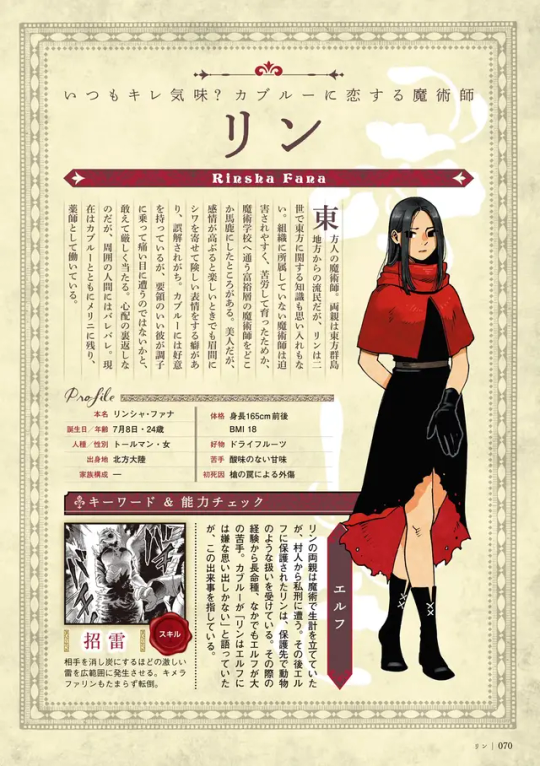
The beginning of her bio reads: 両親は東方群島 東地方からの流民だが.
This translates as: "Her parents were refugees from the eastern region of the Eastern Archipelago."
This is interesting because it's different from the official English translation by Yen Press. Their translation skips the second mention of the east, and also calls her parents wanderers instead of refugees: "Her parents were wanderers from the Eastern Archipelago."
The original Japanese says east twice, 東方群島 (Eastern Archipelago) and 東地方 (Eastern region). I think the translator, a contractor who doesn't have time to fact-check, maybe didn't understand why Rin's bio said east so many times (the sentences before and after also mention "east" many times) and just didn't bother including what seemed like a redundant mention of it.
SO WHAT DOES THAT MEAN?
What it means is we actually know what part of the Archipelago Rin is from!

Obviously this is only speculation, but I would guess her family originally came from one of the islands I've colored in dark gray here, since they are the furthest east part of the Archipelago.
WHAT CULTURE COMES FROM THOSE ISLANDS?
(I talk about some of this in chapter four of my Dungeon Meshi essay in the section about Rin.)
We don't know! However, remember what I said about how the far-east of the Eastern Archipelago is neighbors with the Western Continent?
The Western Continent is a region dominated by western elven culture. Therefore it makes sense that this part of the Archipelago should have had the most contact with the elves, and foreign tall-men who are a part of elven culture. There should be cultural mixing between the two groups... And there is! Rin's name is evidence of it!
Rinsha Fana (رينشا فناء), is an Arabic name. Arabic is one of the languages Kui associates with the Western elves, which would mean that in-universe, Rinsha Fana is an elvish (or at least Western) name.
THE SIMPLE ANSWER
It's possible that there is a fusion culture in the far eastern islands, and it's the natural result of contact between the West and the East.
Since Rin's name is Arabic, we could theorize that the far-east of the Eastern Archipelago is similar to various Asian cultures in the real world that were influenced by the Arabic world historically.
The ones that I could find are Myanmar, Cambodia, Vietnam, Thailand, the Philippines, Brunei, Indonesia, Malaysia, China, Uzbekistan, Kyrgyzstan, Tajikistan, Turkmenistan, and Kazakhstan.
So the Fana family's home island might be similar to any of those! It's a long list, but it does narrow things down a little bit!
THE COMPLICATED ANSWER
In addition to the fact that the far-eastern islands are physically close to the Western Continent and there being some cultural fusion there, we also know that there are groups of elves in Dungeon Meshi who behave similarly to missionaries in the real world.
There may or may not have been a religious component, but these elves felt it was their moral duty to spread elven culture and knowledge (including elven style magic) to the short-lived races, and improve their standard of living.
Since the far eastern islands of the Archipelago are the closest to the West, it makes sense that elven missionaries would have had a presence there, just like it makes sense that they would have had a presence on the far western coast of the Eastern Continent.
It's strongly implied that Rin's parents may have practiced elven-style magic, since if they had practiced Gnomish magic (the dominant style in the Eastern Archipelago and the Northern Continent), they might have been able to join a local organization (a church, a school, a royal court) in the Northern Continent and not been lynched. Something about their magic was "foreign" and scared the people of the Northern Continent.
The original Japanese text explicitly says they were lynched (私刑).
Kui also explicitly tells us that Rin’s family was lynched in the Northern Continent, using the word 私刑. Lynching is an extrajudicial public execution by an in-group against someone who is outside of their social circle, who has somehow “transgressed” against the in-group. Usually the “transgression” is something like being a foreigner, being of a different race, different ethnicity, practicing a different religion, or behaving in any unusual way (being neurodivergent, gender non-conforming or homosexual).
The Fana family fled the Archipelago, didn't change their family name, and then gave their daughter a western/elven personal name as well. This implies that they are unwilling to give up their culture, even under circumstances where it would be safer to assimilate. This suggests that the culture is very important to them.
WHY DID RIN'S FAMILY LEAVE THE EAST?
We don't know exactly, but the original Japanese text says they were refugees. This implies that they left their homeland due to some kind of danger or threat to their lives.
We know that the Eastern Archipelago is constantly at war with itself, and that could be enough reason for a family to flee. But because of the history of Christianity in Japan, Rin's name, and her family's behavior, I think there may be something more to it.
We know that there are treaties between the nations in Dungeon Meshi that prevents the long-lived races from colonizing the Eastern Archipelago. The nations of the Eastern Archipelago most likely consider any influence from the long-lived races a threat to their sovereignty, and they are probably making an effort to keep long-lived races and their culture out of the region.
This sounds very similar to Sakoku (鎖国 Literally "locked country") an isolationist foreign policy in Japan that began at the end of the Sengoku era (the era that Wa appears to be in the middle of). Under this policy, relations and trade between Japan and other countries were severely limited, and nearly all foreign nationals were banned from entering Japan, while common Japanese people were kept from leaving the country.
The sakoku policy was enforced in order to remove colonial and religious influence from European countries, which were perceived as posing a threat to the stability of Japan.
Japanese people who had converted to Christianity were seen as traitors, and missionaries were foreign enemies trying to undermine Japanese society. Conversion to Christianity, the dominant religion of Europe, was seen as the first step of European nations trying to colonize Japan.
Part of the sakoku policy was the Japanese government officially persecuting, torturing, and executing somewhere between 2,000 and 5,000 Japanese Christians and foreign Christian missionaries. This forced Christians in Japan to either go into hiding, flee the country, or renounce their faith in order to survive.
I think an attitude like this towards foreign culture would logically be common throughout the entire Eastern Archipelago, and not just the island of Wa.
So local people like Rin's family who might have adopted Western elven culture (magic, names, clothing, etc.) may have been seen as a threat, and may have been pressured to renounce their ways, or leave.
The cultural backlash would be extreme, and could easily cause civil war and instability, especially in any areas that have a large Western cultural influence, like I've theorized the Fana family's home island to have.
In the end, I think no matter which way you choose to interpret the information, it's clear that Rin's family has a connection to both East Asia and Arabic culture... So start there, and see what cool ideas you can come up with!
50 notes
·
View notes
Text


Oh look it's the grandma boss and his 7 gremlins.
A lot of brainrot happen here and this is the start of this AU where my MFB OC-Sadahiko is the new manager of BTF (Bright to The Future) post-Zero G:
Formerly an undercover agent from WBBA, Sada was send to the newly established young organization-BTF, with the purpose of getting employed as their new manager. The end goal was to lead BTF merging into the WBBA, becoming a smaller section in the bigger organization.
To the adult, BTF is a minor threat yet still a hush of a once threatening organization, yet not that big of a deal. So with time, the WBBA slowly tried to secure their assets and potentially trying to take control over it. This is where Sada came in to the scene.
But later on, through thick and thin, not only Sada didn't get BTF to become a part of WBBA, he and the team successfully made it's own thing, becoming what is known as "the WJBBA" or "West Japan Beyblade Battle Association".
The team is rough around the edge, coming from an semi illegal company to actual legal company with it's employees that was previous dubbed antagonistic. Where will this goes? We will see
#mfb oc#metal fight beyblade#beyblade zero g#beyblade shogun steel#kanoshima sadahiko#mfb AU#fake scene edit#edit by washi#brainrot all the way#long post#washi ramblings
28 notes
·
View notes
Text
The fabrication of a storm god: Susanoo, Taishakuten (Indra) and their histories

When I found this ask in my inbox recently, I initially admittedly wanted to only give a short, dismissive response. After all, the similarity between these two is completely superficial. And, truth to be told, it’s more a vague similarity between how they are presented as “storm gods” by questionable online sources than between their actual roles. However, I quickly realized that would not accomplish much. The best way to counter misconceptions is to show reality is more interesting - and in the case of complex figures with long histories, this requires time and effort.
The response, like the recent Tamamo no Mae one, kept growing as a result, and evolved into a fully blown unplanned post. Under the cut, you will find a brief examination of the origin of the erroneous notion that Susanoo was ever understood a “storm god”, as well as a summary of his character character, the main deities linked to him in the Japanese “middle ages”, and finally his fate after the Meiji restoration. In the second half, I deal with the Japanese reception of Indra. While not actually related to Susanoo, he is nonetheless a complex deity worth exploring, even though it feels like he’s not particularly appreciated by hobbyists and his central role in medieval cosmology hardly gets acknowledged.
Victorian confabulations and Meiji mirages: the fabrication of a storm god
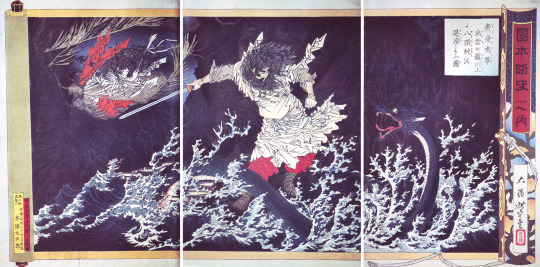
Susanoo vanquishing Yamata no Orochi, as depicted by Yoshitoshi Tsukioka (wikimedia commons)
Contrary to what you might have seen in numerous online sources of dubious quality, Susanoo is not a “storm god” (let alone a “thunder god” more specifically). Nothing to that effect shows up in standard points of reference like Encyclopedia of Shinto, and even Wikipedia despite arbitrarily putting him in the weather god category only musters a single 2000 paper which I’ve never seen cited in subsequent Susanoo research as “evidence” of a weather connection.
The most recent in depth treatments of Susanoo in English are a section of Bernard Faure’s monograph Rage and Ravage and David Weiss’ The God Susanoo and Korea in Japan’s Cultural Memory: Ancient Myths and Modern Empire. The former at no point makes any claims pertaining to the weather while discussing him. The latter notes the view that Susanoo was a “storm god” enjoyed some popularity in the late nineteenth century because of the influence of the now long abandoned school of “nature mythology”, in which deities are only ever representations of natural phenomena. This theory was originally formulated by Edward Burnett Tylor, who basically admitted no actual Japanese sources ever present him as a “storm god”, but that this character is nonetheless evident in his vibes (obviously not how he phrased it, but his study deserves no more dignified summary).
Tylor’s nonsense was subsequently taken up by a certain Edmund Buckle, who randomly connected his forerunner’s oc with Indra because I guess all weather gods are basically interchangeable (there’s an interesting point to be made about how they’re the one group of male deities who are often treated in poor quality scholarship the way goddesses usually are). By 1899, the theory reached Japan, where it caused a prolonged academic debacle. However, it seems supporters of this view, much like in the west, were the followers of the long since abandoned notion of “nature mythology”. Among the theory’s opponents were researchers such as Masaharu Anesaki. As far as I can tell, it’s essentially irrelevant today.
The oldest available information about Susanoo’s actual character comes from the Kojiki and the Nihon Shoki. I don’t think that needs to be discussed here in detail. Even though I often overestimate other people’s familiarity with mythology I think it’s fair to say everyone with just a passing interest in Japan knows at least the basics of the myths about his conflict with his sister Amaterasu, his banishment, and subsequent victory over the serpent Yamata no Orochi. It will suffice to say the oldest recorded mythical image of him is that of an ambivalent deity, a heroic monster slayer on one hand, a transgressor and exile on the other. This polarity remains a core part of him for the rest of his history.
The other early sources dealing with Susanoo are various fudoki, regional records. They indicate that in the eighth century he already was connected with diseases. Later on in the Heian period, he also came to be associated with purification. Or to be more precise - he came to be viewed as the archetypal target of purification, in a way. His misdeeds from classical mythology became examples of deeds requiring such ceremonies, performed variously by courtly ritual specialists like the Nakatomi clan, Buddhist clergy, or onmyōdō masters. He also functioned as a jinushi, a “landholder deity” of often ambivalent character tied to a specific location, and an araburugami, a “raging god” defined by causing havoc out of hubris (as opposed to malice).
Gozu Tennō and others: the network of medieval Susanoo
Susanoo’s character developed through the Japanese “middle ages” in no small part through associations with other deities, typically caused by his incorporation into Buddhism.

A composite Susanoo-Gozu Tennō, as depicted by Sadahide Utagawa (Östasiatiska Museet, Stockholm)
The single most important figure he came to be linked with was by far Gozu Tennō, the “Bull-Headed Heavenly King”. While religious and literary texts present him as a deity from India, the guardian of the Jetavana monastery, and he was even furnished with an artificial Sanskrit name, Gomagriva Devaraja, his origin is actually uncertain. It’s possible he was inspired by a misreading of a passage from the travelog of the Chinese monk Faxian (c. 337-442). He visited Jetavana in the early fifth century, and reported that there was a statue of a bull next to the monastery’s door, before moving on to describing the supposed first image of the Buddha, which according to him was made from legendary “ox-head sandalwood” and impervious to fire. Confusion between these two passages might have led to the creation of an ox-headed deity. Other proposals are present in scholarship too, but ultimately the matter remains unclear.
What is evident is that Susanoo and Gozu Tennō shared many similarities: the latter also was an archetypal “raging deity”, and he too was linked with pestilence. An argument can be made that he was the disease spirit par excellence in medieval Japan, in fact. When properly worshiped, he was supposed to protect the faithful from illnesses, as expected from a deity of this variety. They also shared an association with foreign lands: Gozu Tennō primarily with India, but also with China and Korea, while Susanoo just with Korea, due to a Nihon Shoki episode where he travels to the kingdom of Silla. Yet another point of connection is that both were simultaneously recognized as manifestations of Yakushi (the “medicine Buddha”). Therefore, it comes as no surprise that at the Gion shrine in Kyoto, and in many other locations across Japan, the two were identified fully.
However, the link was at times conceptualized differently than as interchangeability between the two. For instance, Kaneyoshi Ichijō’s treatise Kuji Kongen (公事根源; “Roots of Court Administration and Ceremonies”) Gozu Tennō is merely an “acolyte” (warawabe, 童部) of Susanoo. Granted, this author eventually came to view them as identical himself, which shows how fluid medieval theology could be.
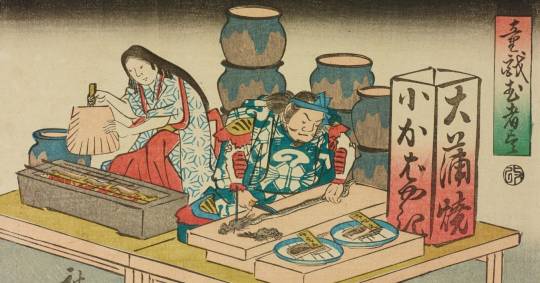
A humorous depiction of Susanoo and Kushinadahime serving pieces of Yamata no Orochi prepared like grilled eel (Ōta Memorial Museum of Art; reproduced here for educational purposes only)
The identification between Susanoo and Gozu Tennō also extended to their wives, respectively Kushinadahime and Harisaijo (波梨采女), as evident for example in the Shaku Nihongi. The latter was regarded as a daughter of the dragon king Sāgara. Things are made slightly awkward by the Nihon Shoki Sanso, where she is a manifestation of Yamata no Orochi (one of the multiple cases of putting a positive spin on the snake). Susanoo in the guise of Gozu Tennō thus effectively marries his nemesis.
The marriage itself is a subject of a number of myths. According to Hoki Naiden (簠簋内伝), an onmyōdō manual, the “heavenly emperor” (Taishakuten, one would presume, based on information I’ll discuss later) de facto played the role of a matchmaker between Harisaijo and Gozu Tennō. When the latter was lamenting that due to his monstrous, yaksha-like form - he had the head of a bull - he will never find love, a bird sent by the celestial ruler informed him that it would be appropriate for him and Sāgara’s daughter to get married. This suggestion then evidently works out just fine, and the couple subsequently have eight children, the Hachiōji (八王子, “eight princes”) over the course of thirty seven years.
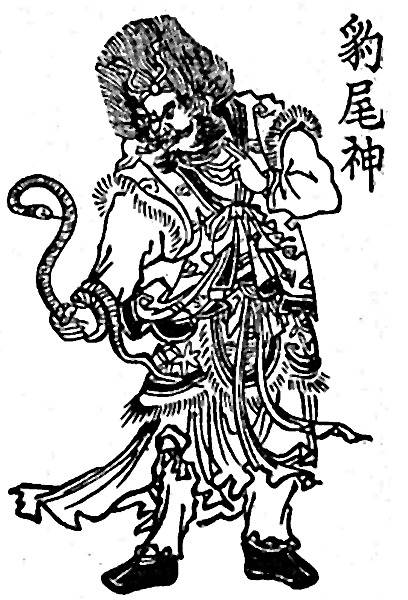
Hyōbi (wikimedia commons)
There are multiple slightly divergent traditions about the identities of the children. The most notable variable is that a goddess named Jadokkeshin (蛇毒気神; also read Dadokuke no kami; “deity of poisonous snake breath”) sometimes appears among them, sometimes is treated as an independent deity serving Gozu Tennō, and sometimes takes the role of his spouse (in at least one case with Harisaijo quite literally relegated to the role of his ex). She is also identified with the astral deity Hyōbi (豹尾, “leopard tail”) and by extension with Ketu.
Another figure who was closely linked with Susanoo in the middle ages was Matarajin. This tradition was associated with Gakuen-ji. In a local legend, Susanoo started to be called Matarajin after being buried underneath it. I won’t dwell much on Matarajin here since I already wrote a lot about him, and will write even more in the near future, so it will suffice to say the two share a connection to diseases. In Matarajin’s case it is the most pronounced in the “ox festival” still held in modern times at Kōryū-ji.

Shinra Myōjin (wikimedia commons)
Connections between Susanoo and Matarajin’s fellow Tendai old man disease-related deities Sekizan Myōjin and Shinra Myōjin are documented too. Bernard Faure argues that in fact it was Shinra Myōjin who first developed such an association, and it was only transferred to Matarajin as well because of the numerous analogies between them.
A distinct tradition regarding Susanoo developed in the theology of Ise (“Ryōbu shintō”), which as expected was Amaterasu-centric (but also Dainichi-centric!). He came to be linked with Mara and Devadatta as a representation of “fundamental ignorance”, with the conflict between him and Amaterasy gaining an additional Buddhist dimension. At the same time, in the noh play Dairokuten (第六天), which deals with Jōkei’s pilgrimage to Ise, Susanoo appears to protect this monk from Mara. Evidently, in this context Susanoo and Amaterasu are hardly opposed to each other, seeing as the former de facto intervenes on behalf of the latter.
While the notion of rivalry between the siblings obviously did not vanish in the middle ages, and in fact new myths about it started to circulate (in one Matarajin assists Susanoo), it can be argued that it was ultimately the new conflict between Amaterasu and Mara that was central to many medieval theologies. While she and Susanoo could be portrayed as antagonistic, there is a case to be made that there were more similarities between medieval ideas about them than there were differences. That was not meant to last, though.
Later developments
The tradition of associating Susanoo with assorted medieval deities first came under criticism in the eighteenth century. Sadakage Amano, an early proponent of kokugaku ("national learning", an early Japanese nationalist ideology) ideas, wrote a treatise dealing with this matter, Gozu Tennō Ben (牛頭天王辨, “Clarification on Gozu Tennō”). Its core premise is that monks and shrine priests alike are deceptively trying to present “foreign” deities as identical with “native” ones. This point was further developed in the nineteenth century by another kokugaku big name, Atsutane Hirata.

Hirata's self portrait (wikimedia commons)
He reaffirmed that presenting Susanoo and Gozu Tennō as related deities was a nefarious plot, and blamed Kibi no Makibi for starting it. He argued that Makibi spent too much time in China and as a result forsake a pristinely Japanese way of thinking (whatever that wouldn't entail). As a result, when he heard the legend of ox-head sandalwood, which was believed to grow on the mythical continent Uttarakuru and cure diseases, he turned it into a deity, who he subsequently brought to Japan. Then he identified him with Susanoo to increase his prestige.
Was that the historical truth? Kibi no Makibi was an envoy to China and spent around 20 years on the mainland, that much is undeniable. However, the only connection between him and Gozu Tennō I was able to track down is a local legend pertaining to Mount Hiromine in which he meets this deity in a dream, though.
Ultimately like most of Hirata’s writing, his theory consists virtually entirely of confabulations, mostly motivated by extreme levels of xenophobia. Rather ironic for a movement which originally largely developed among the most hardcore neo-Confucian thinkers in Japan. Granted, that’s hardly the only baffling thing about them. The best way to understand what was going on in the heads of kokugaku proponents is to recall how contemporary marble bust profile pic “the west has fallen” trads or Bible literalist creationists function, and adjust that image for the specifics of the Edo period.
Still, kokugaku theories, nonsensical as they were, kept developing, and finally gained government support after the Meiji revolution. In 1868, the Council of State proclaimed that shrines can no longer use “inappropriate” names to refer to their deities. Gozu Tennō was the only example brought up directly, in part possibly because with the reestablishment of the power of the emperor and the rise of the imperial cult it was viewed as suspicious that a deity unrelated to the imperial court had the moniker of tennō (written with different signs, though). The edict also contains a blanket ban on any name with the element gongen.
As a result of the new policies numerous locations had to be renamed, and for the most part the history of Gozu Tennō came to an end. He and his peers eventually came back into the spotlight in the second half of the twentieth century as subjects of scholarly inquiries, and the field of study of medieval and early modern Japanese religions is now booming, with entire monographs and articles published in multiple languages each year, but that’s another story.
The history of Susanoo obviously did not end in the 1860s, though. What followed was probably the single darkest page in it, an era of intense efforts to make him identical with Dangun, the legendary founder of Korea. The goal was explicitly to justify Japanese colonial control over Korea through faux-spiritual means. Since Japanese colonial domination of Korea is a relatively recent and deeply serious historical issue compared to what I cover most of the time, I feel it would be inappropriate to deal with it in the same article as medieval literature which ultimately lacks much of a tangible impact on the modern world, so I hope you won’t mind I don’t go deeper into the detail here.
With the matter of Susanoo now settled, let’s move on to Indra. The two were never associated with each other, but the latter developed an equally vibrant network of roles and associated deities around him as Susanoo after being transmitted to Japan.
From Indra to Taishakuten

A typical Hindu depiction of thousand-eyed Indra (wikimedia commons)
Indra has a long and complex history, so long he is in fact attested a handful of times in bronze age cuneiform already as one of the notoriously mysterious non-Hurrian Mitanni deities (sic), invoked as personal deities of the royal house in a lengthy treaty oath. This makes him one of the very few “bridges” between my two major normally disconnected interests (the “cuneiform world” on one hand, and East Asian religions and art on the other).
The biggest early text corpus dealing with Indra are the Vedas, where he is the single most frequently mentioned deity, with quite literally hundreds of hymns praising him. Naturally, he remained a part of the history of Hinduism later on, and today he is still well known thanks to his role in popular epics like Ramayana. His relevance is not limited to this system of beliefs alone, though. He has a small (negative) role in the Avesta (see here), and he was embraced by various schools of Buddhism across much of Asia.
In early Buddhism, the prestige of Indra was not particularly great. This obviously reflects the fact that the formative years of Buddhism were also a period of Indra’s relative decline as an actively worshiped god back at home at the expense of deities central in contemporary Hinduism like Vishnu and Shiva. However, he surprisingly regained some of his original prestige thanks to developments which occurred outside of India. This is well documented in East Asia in particular. I’ll only cover his Japanese reception here - therefore, through most of the rest of the article I will use his Japanese name, Taishakuten (帝釈天), accordingly.
Buddhism emphasizes not Indra’s warlike side and his battles with asuras, let alone a connection with the weather, but rather his role as a heavenly ruler. He keeps epithets related to his 1000 eyes, but to the best of my knowledge this is not really reflected in Buddhist art, especially not in Japan. Another role retained by him in Buddhism is that of a directional deity, the protector of the east.
Something that’s worth highlighting is that asuras in general just aren’t that big of a deal in Japanese Buddhism. Outside of enumerations of non-human sentient beings, only Rahu and Ketu have a substantial role, and that’s more because they’re astral deities rather than because they’re asuras. Otherwise the entire category is about as opaque as mahoragas (when you look up “mahoraga” online 99% results are a Jujutsu Kaisen character, as it turns out, which speaks volumes about their general obscurity) and the like. Hard to make opposition to them the focus of a major deity when even gandharvas have a bigger role to play.
I can only think of a handful of major references to battles between Taishakuten and asuras in Japanese literature: an offhand comment in Heike Monogatari (courtesy of Kenreimon-in), a passage from the Taiheiki where Jōkei (who you already met earlier in this article) has the privilege to watch the parties involved reenact the conflict for his benefit, and a myth cited by Annen with no source provided, possibly invented by him. The innovation is that Marici (Marishiten) is a major combatant on the side of the devas, something with no parallel in any other source, whether Buddhist or Hindu. Rahu is singled out among the asuras as an enemy of Taishakuten, but that’s hardly unparalleled.
The conventional image of Taishakuten
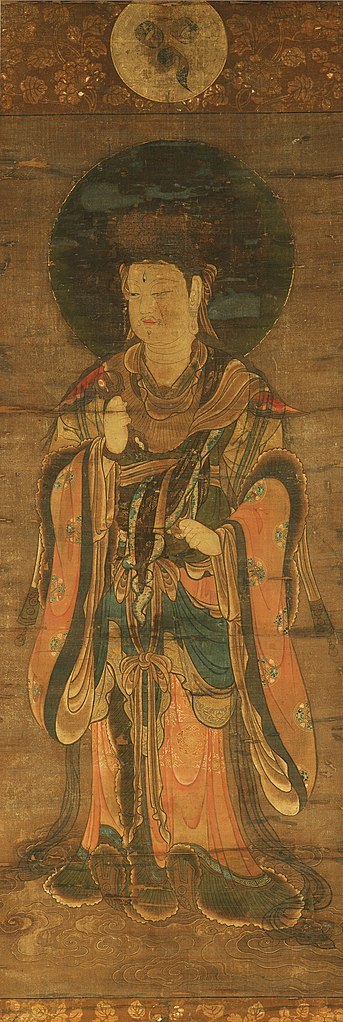
A conventional depiction of Taishakuten (wikimedia commons)
For the average Japanese person through much of the country’s history, the most frequent exposure to Taishakuten were standardized oath formulas (kishōmon). These followed a strict hierarchy of deities: Taishakuten, Bonten (Brahma) and the four heavenly kings first, then king Enma, Godo Daishin (Wudao Dashen), Taizan Fukun and other underworld officials (sometimes assisted by astral figures), then kami and representations of Buddhas tied to specific localities (for example the great Buddha of Tōdai-ji), and sometimes various religiously significant historical figures like prince Shotoku or Buddhist patriarchs. Obviously, Taishakuten’s elevated position reflects his role as a heavenly ruler - the “heavenly emperor”, tentei (天帝).
The residence of Taishakuten is the heaven of the thirty three devas (忉利天, Tōriten, a calque from Sanskrit Trāyastriṃśa). It is located on Mount Sumeru, the center of the world according to Buddhist cosmology. Sources from the Heian period indicate the existence of a belief Taishakuten’s heaven is unique in that women could be reborn in it after death without first reincarnating as men. This distinction was otherwise only attributed to the pure land of Maitreya. Note it was not Taishakuten himself who was responsible for guaranteeing that, though, but rather the bodhisattva Fugen, who was particularly popular among Heian court ladies.
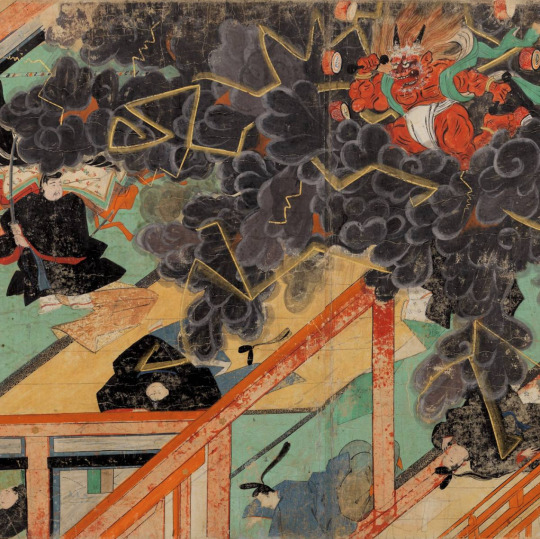
Karai Tenjin (wikimedia commons)
Taishakuiten’s major position in the Buddhist-influenced cosmos is also evident in literary compositions focused on other deities. For example, in the Dōken Shōnin Meidoki (道賢上人冥途記, “Record of Dōken Shōnin’s Experience of the Other World”), a version of the legend of Michizane, his revenge is supported by Taishakuten, who gives him a new name, Nihon Dajō Itoku Ten (日本太政威徳天). This is meant to show his banishment was a religious transgression, and we also learn that the emperor responsible for it, Daigo, fell into hell as a result. However, esoteric Buddhism is also credited with calming Michizane down - as he explains himself, “bodhisattvas (...) were there, and they enthusiastically propagated the esoteric teachings. Because I liked these teachings very much, one-tenth of my deeply seated enmity from my past was reduced.”
This obviously goes against the more common legend where being enshrined pacifies Michizabe entirely. In the Dōken version he announces that the enshrined deity, who he calls Karai Taiki Dokuō (火雷大気毒王; “King of Fire-Thunder and Poisonous Air”), is merely his messenger #3 (#1 and #2 are not mentioned).
The closest thing I can think of to Taishakuten being associated with the weather in Japanese sources occurs in a version of the Michizane legend, too: in another variant, Michizane states it was Taishakuten alone who permitted him to enact his vengeance and entrusted him with commanding 105000 thunder gods (in the Dōken Shōnin Meidoki there are 168000 attendants instead, “poisonous dragons, evil demons, deities of water and fire, thunder and lightning, the director of the wind, the master of the rain, and other poisonous, harmful, and evil deities”) and causing disasters.
From emperor to heaven to controller of fate
Due to his prominent cosmological role Taishakuten is also described in many sources as a controller of fate responsible for determining the lifespans of living beings. Sometimes, in this capacity he basically overlaps with king Enma - for example, Shishi Yaloan, a Buddhist encyclopedia from the eleventh century, states that he also possesses a mirror in which he can check on his subjects. A local tradition from Tateyama states that he lives on the Taishaku Peak of Mt. Tate, simultaneously regarded as an entrance to Buddhist hell. However, while Enma and the other kings of hell generally stay there, Taishakuten takes a more proactive role, seeking information about the good and bad deeds of the living. Initially, it was believed that a survey of the whole world was conducted on his behalf by the four heavenly kings, but by the tenth century, a belief that he performs it himself every four months himself developed.

The famously unconventional depiction of Taishakuten from Shibamata Taishakuten, still distributed today in the form of ofuda (wikimedia commons)
In the Edo period, Taishakuten as a controller of fate developed a connection with deities associated with the tradition of kōshin nights. In this context he became the deity the three worms living in every person’s body report their good and bad deeds to. Temples associated with him, like Shibamata Taishakuten (famous among other things for its unconventional images of the eponymous deity), were historically a popular destination for pilgrimages tied to kōshin celebrations.
While the fate connection ultimately came to the forefront in Japan, it would be unfair to say it entirely superseded the original heavenly role. As a matter of fact, it was the fact that Taishakuten was a “heavenly emperor” (tentei) that made him such a good fit for kōshin.
The elusive "emissary of Taishaku"
As early as in the Muromachi period, yet another deity came to be viewed as responsible for Taishakuten's survey of the world in a variant tradition: one of the so-called “ambulatory deities” (遊行神, yugyōjin; “ambulatory” as in “wandering”, not in the medical sense) , Ten’ichi(jin) (天一神; also read Nakagami), literally “the first deity of heaven”. He was regarded as a “vassal” of Taishakuten and the commander of the Twelve Heavenly Generals. Each of his cyclical surveys of the world lasted 44 days (four times five days for each of the main directions and then four times six for the intermediate ones). That was followed by sixteen days during which he reported the vices and virtues he recorded to Taishakuten in heaven, with his own underling Nichiyū(jin) (日遊神; “playing sun deity”) descending to earth instead.
During Tenichi’s absence, which started with a day referred to as Ten’ichi tenjō (天一天上), directional taboos pertaining to various astral deities, which normally had to be countered with a practice known as “changing directions” (方違え, katatagae), did not apply.
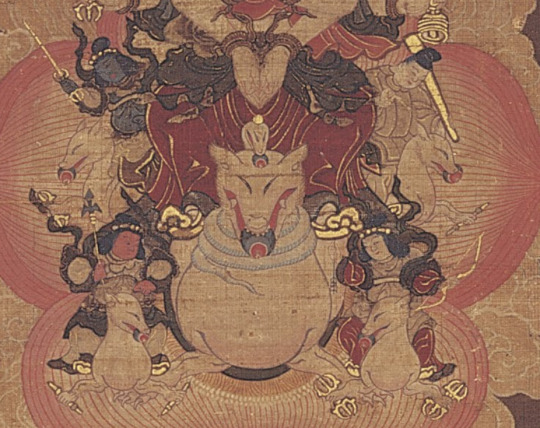
Taishaku Shisha (top right) and his peers accompanying Dakiniten (wikimedia commons)
Another interesting thing about Ten’ichi is that he was identified with an elusive deity known simply as Taishaku Shisha (帝釈使者), literally “emissary of Taishaku”. At first glance this doesn’t really sound interesting - after all, Taishaku Shisha’s name sounds exactly like what Ten’ichi does - but completely unexpectedly, the former actually belongs to the entourage of Dakiniten. His attributes make him resemble officials of the underworld, though he is never portrayed as menacing, always as benign, and his duty is to report the good and bad deeds to his superiors, much like Ten’ichi does. He additionally functions as a god of wisdom, which according to Bernard Faure might reflect Dakiniten’s link to the bodhisattva Monju, famous due to an association with this concept.
Curiously, while Taishaku Shisha is at least nominally a member of a group of four “acolytes” of Dakiniten alongside Tennyoshi (天女子; “heavenly maiden”; holds a bow), Shakunyoshi (赤女子; “red maiden”; holds a halberd and a “seduction jewel”, aikei-gyoku, 愛敬玉) and Kokunyoshi (黒女子; “black maiden”; holds a sword and a black jewel), he is sometimes described as de facto separate from them. Perhaps the fact his very name links him with another deity has something to do with that. Also, he is absent from the origin myth of the three maidens, who according to Hoki Naiden flew to Japan from India. According to Bernard Faure, it is possible his roles overlapped in part with Dakiniten’s own emissaries, the tengu Tonyūgyō (頓遊行; brings happiness) and Suyochisō (須臾馳走; brings longevity).
Dakiniten, “demon kings” and Amaterasu: the network of Taishakuten
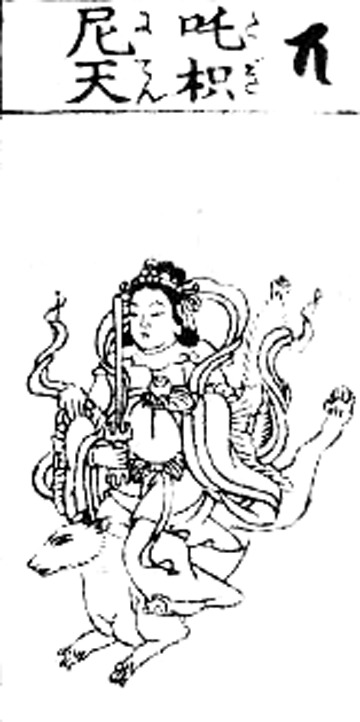
Dakiniten (wikimedia commons)
Taishakuten’s connection with Dakiniten goes beyond the figure of Taishaku Shisa. The Mizōukyo (未曽有經) contains a myth according to which a fox once tricked Indra into accepting the animal as his master is recorded. It serves as an explanation for the notably fox-like Dakiniten’s elevated role in the royal ascension rite devised by Shingon priests (it was still performed in the 19th century, emperor Meiji was the first to abstain from it). In folk beliefs Taishakuten was also sometimes assigned the role of the “master of the foxes”, which normally belonged to her instead.
The link to these animals according to Bernard Faure might have reflected a more ambivalent perception of Taishakuten than usually expected. The other possible piece of evidence in favor of this interpretation is a poem which proclaims that he and Tsuno Daishi, the demonic manifestation of Ryōgen, look “like brothers”. The latter is a complex figure, but it will suffice to say here that historically he was sometimes perceived as a “demon king” (魔王, maō). On the other hand, the original holder of this title, the “Demon King of the Sixth Heaven” (in other words, Mara) was said to offer his blood to Taishakuten on “blood-shunning days” (地幅, chi-imbi). In practical terms, this meant a religious prohibition on the drawing of blood, acupuncture and moxibustion on a specific day, different each month.
I need to stress here that even though figures such as Dakiniten and the “demon kings” obviously originated in the realm of demonology - respectively as a flesh-eating, vital essence-stealing demon and as the tempter of the Buddha - they eventually developed much more complex and nuanced characters. Therefore, it is not unexpected major deities appear in association with them. In the middle ages, even Amaterasu was frequently linked with them.
Funnily enough, in contrast with Susanoo Amaterasu does have a connection to Taishakuten as well. Tenshō Daijin Kuketsu (天照大神口決; “Oral Transmission.Pertaining to the Great Goddess Amaterasu”) from 1328 states that she corresponds to him - but also to Bonten, Shōten (Ganesha), the kushōjin (倶生神; these would take a bit to explain), king Enma and Godō Daijin. Granted, another roughly contemporary treatise, Reikiki, instead proclaims Taishakuten, the “heavenly emperor” (tentei; just like in the later kōshin tradition) the “kami-body” of Toyouke, the outer shrine Ise deity. However, these matters ultimately go beyond the scope of this response. Stay tuned for my article about medieval Amaterasu to find out more!
Bibliography
Ryūichi Abe, Women and the “Heike Nōkyō”: the Dragon Princess, the Jewel and the Buddha
Bernard Faure, The Fluid Pantheon (Gods of Medieval Japan vol. 1)
Idem, Protectors and Predators (Gods of Medieval Japan vol. 2)
Idem, Rage and Ravage (Gods of Medieval Japan vol. 3)
Gerald Gromer, A Year in Seventeenth-Century Kyoto. Edo-Period Writings on Annual Ceremonies, Festivals, and Customs
Takuya Hino, The Daoist Facet of Kinpusen and Sugawara no Michizane Worship in the Dōken Shōnin Meidoki: A Translation of the Dōken Shōnin Meidoki
Nobumi Iyanaga, Medieval Shintō as a Form of 'Japanese Hinduism': An Attempt at Understanding Early Medieval Shintō
William Lindsey, Religion and the Good Life: Motivation, Myth, and Metaphor in a Tokugawa Female Lifestyle Guide
Fabio Rambelli, Before the First Buddha: Medieval Japanese Cosmogony and the Quest for the Primeval Kami
Hiroo Satō, Wrathful Deities and Saving Deities in: Fabio Rambelli and Mark Teeuwen (eds.), Buddhas and Kami in Japan. Honji Suijaku as a Combinatory Paradigm
Idem, The Emergence of Shinkoku (Land of the Gods) Ideology in Japan in: Henk Blezer and Mark Teeuwen (eds.), Challenging Paradigms. Buddhism and Nativism: Framing Identity Discourse in Buddhist Environments
David Weiss, The God Susanoo and Korea in Japan’s Cultural Memory: Ancient Myths and Modern Empire.
90 notes
·
View notes
Text
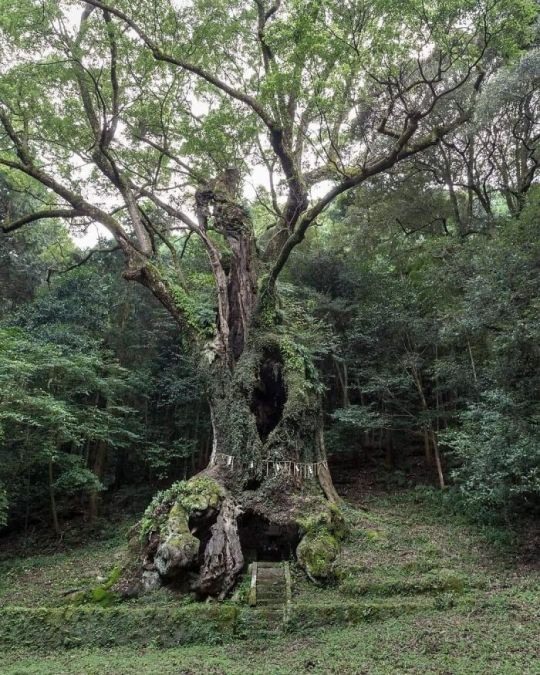
Takeo's Okusu Tree
Over 3000 years old, this camphor tree is the 7th largest tree in Japan. It is 30m tall with a trunk circumference of 20m, its branches span 30m wide from east to west, and 33m wide from north to south. This is the sacred tree of Takeo Shrine, which was built in the Nara period (735 CE). The roots of the tree resemble the feet of elephants and are wrapped in rough bark, with their central section split open near the surface of the ground. Inside is a gaping cavity with an area of 12 tatami mats, which houses a stone shrine deep within.
#japan#Takeo's Okusu Tree#okusu tree#sacred tree#camphor tree#Takeo shrine#Nara period#beauty#beautiful#nature#landscape#scenery#photography
29 notes
·
View notes
Text

J.4.4 What is the “economic structural crisis”?
There is an ongoing structural crisis in the global capitalist economy. Compared to the post-war “Golden Age” of 1950 to 1973, the period from 1974 has seen a continual worsening in economic performance in the West and for Japan. For example, growth is lower, unemployment is far higher, labour productivity lower as is investment. Average rates of unemployment in the major industrialised countries have risen sharply since 1973, especially after 1979. Unemployment “in the advanced capitalist countries … increased by 56 per cent between 1973 and 1980 (from an average 3.4 per cent to 5.3 per cent of the labour force) and by another 50 per cent since then (from 5.3 per cent of the labour force in 1980 to 8.0 per cent in 1994).” Job insecurity has increased with, for example, the USA, having the worse job insecurity since the depression of the 1930s. [Takis Fotopoulos, Towards and Inclusive Democracy, p. 35 and p. 141] In addition, the world economy have become far less stable with regular financial crises sweeping the world of de-regulated capitalism every few years or so.
This crisis is not confined to the economy. It extends into the ecological and the social, with the quality of life and well-being decreasing as GDP grows (as we noted in section C.10, economic factors cannot, and do not, indicate human happiness). However, here we discuss economic factors. This does not imply that the social and ecological crises are unimportant or are reducible to the economy. Far from it. We concentrate on the economic factor simply because this is the factor usually stressed by the establishment and it is useful to indicate the divergence of reality and hype we are currently being subjected to.
Ironically enough, as Marxist Robert Brenner points out, “as the neo-classical medicine has been administered in even stronger doses, the economy has performed steadily less well. The 1970s were worse than the 1960s, the 1980s worse than the 1970s, and the 1990s have been worse than the 1980s.” [“The Economics of Global Turbulence”, New Left Review, no. 229, p. 236] This is ironic because during the crisis of Keynesianism in the 1970s the right argued that too much equality and democracy harmed the economy, and so us all worse-of in the long run (due to lower growth, sluggish investment and so on). However, after decades of pro-capitalist governments, rising inequality, increased freedom for capital and its owners and managers, the weakening of trade unions and so on, economic growth has become worse!
If we look at the USA in the 1990s (usually presented as an economy that “got it right”) we find that the “cyclical upturn of the 1990s has, in terms of the main macro-economic indicators of growth — output, investment, productivity, and real compensation — has been even less dynamic than its relatively weak predecessors of the 1980s and the 1970s (not to mention those of the 1950s and 1960s).” [Brenner, Op. Cit., p. 5] Of course, the economy is presented as a success — inequality is growing, the rich are getting richer and wealth is concentrating into fewer and fewer hands and so for the rich and finance capital, it can be considered a “Golden Age” and so is presented as such by the media. As economist Paul Krugman summarises, in America while the bulk of the population are working longer and harder to make ends meet “the really big gains went to the really, really rich.” In fact, “only the top 1 percent has done better since the 1970s than it did in the generation after World War II. Once you get way up the scale, however, the gains have been spectacular — the top tenth of a percent saw its income rise fivefold, and the top .01 percent of American is seven times richer than they were in 1973.” Significantly, the top 0.1% of Americans, a class with a minimum income of about $1.3 million and an average of about $3.5 million, receives more than 7 percent of all income — up from just 2.2 percent in 1979.” [The Conscience of a Liberal, p. 129 and p. 259]
So it is for this reason that it may be wrong to term this slow rot a “crisis” as it is hardly one for the ruling elite as their share in social wealth, power and income has steadily increased over this period. However, for the majority it is undoubtedly a crisis (the term “silent depression” has been accurately used to describe this). Unsurprisingly, when the chickens came home to roost under the Bush Junta and the elite faced economic collapse, the state bailed them out.
The only countries which saw substantial and dynamic growth after 1973 where those which used state intervention to violate the eternal “laws” of neo-classical economics, namely the South East Asian countries (in this they followed the example of Japan which had used state intervention to grow at massive rates after the war). Of course, before the economic crisis of 1997, capitalist ideologues argued that these countries were classic examples of “free market” economies. Right-wing icon F.A von Hayek asserted that “South Korea and other newcomers” had “discovered the benefits of free markets.” [1980s Unemployment and the Unions, p. 113] In 1995, the Heritage Foundation (a right-wing think-tank) released its index of economic freedom. Four of the top seven countries were Asian, including Japan and Taiwan. All the Asian countries struggling just a few years later qualified as “free.” Yet, as mentioned in section C.10.1, such claims were manifestly false: “it was not laissez-faire policies that induced their spectacular growth. As a number of studies have shown, the expansion of the Asian Tigers was based on massive state intervention that boosted their export sectors, by public policies involving not only heavy protectionism but even deliberate distortion of market prices to stimulate investment and trade.” [Fotopoulos, Op. Cit., p. 115] Moreover, for a long period these countries also banned unions and protest, but then for the right “free markets” always seem compatible with lack of freedom for workers to organise.
Needless to say, after the crisis of the late 1990s, the free-marketeers discovered the statism that had always been there and danced happily on the grave of what used to be called “the Asian miracle”. It was perverse to see the supporters of “free-market” capitalism concluding that history was rendering its verdict on the Asian model of capitalism while placing into the Memory Hole the awkward fact that until the crisis they themselves had taken great pains to deny that such a model existed! Such hypocrisy is not only truly sickening, it also undermines their own case for the wonders of “the market.” For until the crisis appeared, the world’s investors — which is to say “the market” — saw nothing but golden opportunities ahead for these “free” economies. They showed their faith by shoving billions into Asian equity markets, while foreign banks contentedly handed out billions in loans. If Asia’s problems were systemic and the result of these countries’ statist policies, then investors’ failure to recognise this earlier is a blow against the market, not for it.
So, as can be seen, the global economy has been marked by an increasing stagnation, the slowing down of growth, weak (and jobless) recoveries, speculative bubbles driving what growth there is and increasing financial instability producing regular and deepening crisis. This is despite (or, more likely, because of) the free market reforms imposed and the deregulation of finance capital (we say “because of” simply because neo-classical economics argue that pro-market reforms would increase growth and improve the economy, but as we noted in section C.1 such economics has little basis in reality and so their recommendations are hardly going to produce positive results). Of course as the ruling class have been doing well this underlying slowdown has been ignored and obviously claims of crisis are only raised when economic distress reach the elite.
Crisis (particularly financial crisis) has become increasingly visible, reflecting the underlying weakness of the global economy (rising inequality, lack of investment in producing real goods in favour of speculation in finance, etc.). This underlying weakness has been hidden by the speculator performance of the world’s stock markets, which, ironically enough, has helped create that weakness to begin with! As one expert on Wall Street argues, “Bond markets … hate economic strength … Stocks generally behave badly just as the real economy is at its strongest … Stocks thrive on a cool economy, and wither in a hot one.” In other words, real economic weakness is reflected in financial strength. Unsurprisingly, then, ”[w]hat might be called the rentier share of the corporate surplus — dividends plus interest as a percentage of pre-tax profits and interest — has risen sharply, from 20–30% in the 1950s to 60% in the 1990s.” [Doug Henwood, Wall Street, p. 124 and p. 73]
This helps explain the stagnation which has afflicted the economies of the west. The rich have been placing more of their ever-expanding wealth in stocks, allowing this market to rise in the face of general economic torpor. Rather than being used for investment, surplus is being funnelled into the finance market (retained earnings in the US have decreased as interest and dividend payments have increased [Brenner, Op. Cit., p. 210]). However, such markets do concentrate wealth very successfully even if “the US financial system performs dismally at its advertised task, that of efficiently directing society’s savings towards their optimal investment pursuits. The system is stupefyingly expensive, gives terrible signals for the allocation of capital, and has surprisingly little to do with real investment.” [Henwood, Op. Cit., p. 3] As most investment comes from internal funds, the rise in the rentiers share of the surplus has meant less investment and so the stagnation of the economy. The weakening economy has increased financial strength, which in turn leads to a weakening in the real economy. A vicious circle, and one reflected in the slowing of economic growth over the last 30 years.
The increasing dominance of finance capital has, in effect, created a market for government policies. As finance capital has become increasingly global in nature governments must secure, protect and expand the field of profit-making for financial capital and transnational corporations, otherwise they will be punished by dis-investment by global markets (i.e. finance capital). These policies have been at the expense of the underlying economy in general, and of the working class in particular:
“Rentier power was directed at labour, both organised and unorganised ranks of wage earners, because it regarded rising wages as a principal threat to the stable order. For obvious reasons, this goal was never stated very clearly, but financial markets understood the centrality of the struggle: protecting the value of their capital required the suppression of labour incomes.” [William Greider, One World, Ready or Not, p. 302]
For example, “the practical effect of finance capital’s hegemony was to lock the advanced economies and their governments in a malignant spiral, restricting them to bad choices. Like bondholders in general, the new governing consensus explicitly assumed that faster economic growth was dangerous — threatening to the stable financial order — so nations were effectively blocked from measures that might reduce permanent unemployment or ameliorate the decline in wages … The reality of slow growth, in turn, drove the governments into their deepening indebtedness, since the disappointing growth inevitably undermined tax revenues while it expanded the public welfare costs. The rentier regime repeatedly instructed governments to reform their spending priorities — that is, withdraw benefits from dependent citizens.” [Greider, Op. Cit., pp. 297–8]
Of course, industrial capital also hates labour, so there is a basis of an alliance between the two sides of capital, even if they do disagree over the specifics of the economic policies implemented. Given that a key aspect of the neo-liberal reforms was the transformation of the labour market from a post-war sellers’ market to a nineteenth century buyers’ market with its related effects on workplace discipline, wage claims and proneness to strike, industrial capital could not but be happy even if its members quibbled over details. Doug Henwood correctly argues that “Liberals and populists often search for potential allies among industrialists, reasoning that even if financial interests suffer in a boom, firms that trade in real, rather than fictitious, products would thrive when growth is strong. In general, industrialists are less sympathetic to these arguments. Employers in any industry like slack in the labour market; it makes for a pliant workforce, one unlikely to make demands or resist speedups.” In addition, “many non-financial corporations have heavy financial interests.” [Op. Cit., p. 123 and p. 135]
Thus the general stagnation afflicting much of the world, a stagnation which regularly develop into open crisis as the needs of finance undermine the real economy which, ultimately, it is dependent upon. The contradiction between short term profits and long term survival inherent in capitalism strikes again.
Crisis, as we have noted above, has appeared in areas previously considered as strong economies and it has been spreading. An important aspect of this crisis is the tendency for productive capacity to outstrip effective demand, which arises in large part from the imbalance between capitalists’ need for a high rate of profit and their simultaneous need to ensure that workers have enough wealth and income so that they can keep buying the products on which those profits depend. Inequality has been increasing particularly in neo-liberal countries like the UK and USA, which means that the economy faces as realisation crisis (see section C.7), a crisis which was avoided in the short-term by deepening debt for working people (debt levels more than doubled between the 1950s to the 1990s, from 25% to over 60%). In 2007, the chickens came hole to roost with a global credit crunch much worse than the previous finance crises of the neo-liberal era.
Over-investment has been magnified due to the East-Asian Tigers and China which, thanks to their intervention in the market (and repressive regimes against labour), ensured they were a more profitable place to invest than elsewhere. Capital flooded into the area, ensuring a relative over-investment was inevitable. As we argued in section C.7.2, crisis is possible simply due to the lack of information provided by the price mechanism — economic agents can react in such a way that the collective result of individually rational decisions is irrational. Thus the desire to reap profits in the Tiger economies resulted in a squeeze in profits as the aggregate investment decisions resulted in over-investment, and so over-production and falling profits.
In effect, the South East Asian economies suffered from the “fallacy of composition.” When you are the first Asian export-driven economy, you are competing with high-cost Western producers and so your cheap workers, low taxes and lax environmental laws allow you to under-cut your competitors and make profits. However, as more tigers joined into the market, they end up competing against each other and so their profit margins would decrease towards their actual cost price rather than that of Western firms. With the decrease in profits, the capital that flowed into the region flowed back out, thus creating a crisis (and proving, incidentally, that free markets are destabilising and do not secure the best of all possible outcomes). Thus, the rentier regime, after weakening the Western economies, helped destabilise the Eastern ones too.
So, in the short-run, many large corporations and financial companies solved their profit problems by expanding production into “underdeveloped” countries so as to take advantage of the cheap labour there (and the state repression which ensured that cheapness) along with weaker environmental laws and lower taxes. Yet gradually they are running out of third-world populations to exploit. For the very process of “development” stimulated by the presence of Transnational Corporations in third-world nations increases competition and so, potentially, over-investment and, even more importantly, produces resistance in the form of unions, rebellions and so on, which tend to exert a downward pressure on the level of exploitation and profits.
This process reflects, in many ways, the rise of finance capital in the 1970s. In the 1950s and 1960s, existing industrialised nations experienced increased competition from Japan and Germany. As these nations re-industrialised, they placed increased pressure on the USA and other nations, reducing the global “degree of monopoly” and forcing them to compete with lower cost producers. In addition, full employment produced increasing resistance on the shop floor and in society as a whole (see section C.7.1), squeezing profits even more. Thus a combination of class struggle and global over-capacity resulted in the 1970s crisis. With the inability of the real economy, especially the manufacturing sector, to provide an adequate return, capital shifted into finance. In effect, it ran away from the success of working people asserting their rights at the point of production and elsewhere. This, combined with increased international competition, ensured the rise of finance capital which in return ensured the current stagnationist tendencies in the economy (tendencies made worse by the rise of the Asian Tiger economies in the 1980s).
From the contradictions between finance capital and the real economy, between capitalists’ need for profit and human needs, between over-capacity and demand, and others, there has emerged what appears to be a long-term trend toward permanent stagnation of the capitalist economy with what growth spurts which do exist being fuelled by speculative bubbles as well as its benefits being monopolised by the few (so refuting the notion of “trickle down” economics). This trend has been apparent for several decades, as evidenced by the continuous upward adjustment of the rate of unemployment officially considered to be “normal” or “acceptable” during those decades, and by other symptoms as well such as falling growth, lower rates of profit and so on.
This stagnation has became even more obvious by the development of deep crisis in many countries at the end of the 2000s. This caused central banks to intervene in order to try and revive the real economies that have suffered under their rentier inspired policies since the 1970s. Such action may just ensure continued stagnation and reflated bubbles rather than a real-up turn. One thing is true, however, and that is the working class will pay the price of any “solution” — unless they organise and get rid of capitalism and the state. Ultimately, capitalism need profits to survive and such profits came from the fact that workers do not have economic liberty. Thus any “solution” within a capitalist framework means the increased oppression and exploitation of working class people.
#community building#practical anarchy#practical anarchism#anarchist society#practical#faq#anarchy faq#revolution#anarchism#daily posts#communism#anti capitalist#anti capitalism#late stage capitalism#organization#grassroots#grass roots#anarchists#libraries#leftism#social issues#economy#economics#climate change#climate crisis#climate#ecology#anarchy works#environmentalism#environment
26 notes
·
View notes
Note
my unpopular opinion, i think flat earth is totally plausible. i've seen theories where there are like 20 other continents outside of the 7 that we know. our 7 are completely surrounded by a strip of land, obviously forming a circle, called antarctica. it's forming a wall of sorts, blocking our 7 continents from the 20 other contents on the other side and our 7 continents are trying to keep those other 20 a secret from it's inhabitants for some reason... why else would every country agree to make it illegal for normal citizens to travel to antarctica? they're either doing something they don't want anybody to know about, they've discovered something they don't wan anybody to know about, or they don't want anybody to know about the world outside of our 7 continents. i know there's like proof from space and whatnot that the earth is a sphere, i do believe that but i still feel like flat earth with more than just 7 continents logically makes sense.
i also think the american moon landing was faked. countries were in a race to get to the moon first and the american government faked it so they could say they got there first.
i also believe cats are aliens, there was a race of cat aliens that came to earth and helped egyptians build the pyramids and that's why they worshiped cats. the tops of pyramids were their space crafts and that's why the pyramids do not have their tops anymore, because the cat aliens left earth in their space crafts but they left domesticable cats behind.
octopus are also aliens, they have alien dna.
i whole heartedly believe that they replaced biden with a lookalike, you can see subtle differences (and not subtle differences, nobody becomes president with detached earlobes only to end their term with attached earlobes). also the american government has been taken over by a species of lizard alien/people, other countries governments (like russia's) as well.
avril lavigne was also replaced by a lookalike.
now some honestly more believable ones... i think yellowstone is going to erupt within the next few years, taking out entire middle section of the united states. i wouldn't say it's due for a cataclysmic eruption, volcanoes can't be predicted like that. but the magma levels have risen 3 inches per year for the past 3 years.
the san andres fault is also due for a major earth quake, one that with change the united states (at least) forever. the entire west coast of the country is going to fall into the ocean which will cause a huge tsunami either to the united states or it will travel as far as japan, taiwan, and the philippines... possibly even indonesia, papua nuew guinea, and australia - plus all the smaller islands in between.
i actually don't know if these would be considered unpopular opinions but they're my opinions and idk how many other people believe any of this is true.
#and youre big into skz or ? lmaoooo#imma be honest i laregly didnt read this im sorry#thats too many words for lil ol me#i iust wanted to make this chan video#i think this is what i look like in the alternate universe where im a dude
17 notes
·
View notes
Text

"I've noticed that younger fans seem to have trouble connecting the dots that a lot of adults on this website were kids younger or close to the age of Yusuke when this series was originally airing back in the 90s in Japan and the 2000s in the west.
Although these fictional characters' stories ended for them at 18 it doesn't mean that Yusuke and the gang stop being important, interesting, or compelling to us. It also doesn't mean that we have to stop loving these fictional characters and their stories after we turn 19.
If you as a minor 14-17 or someone aged 18 - 25 thay feels comfortable shipping these characters, viewing art of them, and reading fic about them ESPECIALLY NSFW art/fic; but your skin crawls that people older than you are creating that content, then you need to sit down with yourself and ask yourself if fandoms that are literally older than your existence are places that you are ready to be socializing in.
Fandoms that are older than your existence will have fans that are MUCH older than you and they are making content and having interactive conversations.
Yu Yu Hakusho is not an Adult Only fandom but it is a fandom that is Mostly Adults.
I fell in love with this show when I was a pre teen. I'm in my mid 30s. The show's target audience is teenagers. But here is the thing: it's target audience was teenagers back in the 90s and 2000s and that's still most of its audience today because Togashi told a fun and resonant story that tends to stick with its audience.
If you can't handle shipping content or adult conversations (conversations about mature topics and themes not necessarily 18+/NSFW but these are definitely present also) about Yu Yu Hakusho then you should try to avoid adult spaces when searching for discussion or content and stick to spaces specifically for minors.
A space specifically for minors would have a ban against all 18+/NSFW content that is strictly enforced. It would not have an 18+/NSFW section at all.
Tumblr and most of the discord servers for YYH that I've seen are adult spaces. Because there is an expectation that while minors are allowed on the websites they must be over a certain age with parental permission because adult conversations happen here where minors could see them.
All of this to say: Unplug from the adult spaces if you feel uncomfortable with adult themes and content or 18+/NSFW content.
Talk to friends irl about Yu Yu Hakusho or find a minor focused space online to talk about it. Come back to the adult spaces in a few years.
This applies to the 18 - 25 crowd also. If you can't handle seeing someone ship these characters or if someone ships them in a way that you don't agree with and it's so upsetting to you that it's causing you a great deal of anger or distress then you need to consider if you really want to be in the Greater Online Yu Yu Hakusho Fandom at this particular point in your life. Or if maybe you want to filter tags on tumblr and drop sites that you can't filter to make your fandom experience more smooth.
If Yu Yu Hakusho has lasted 30 years then it'll last another 3 or 5 years while you get adjusted and engage with Yu Yu Hakusho in minor focused or safely filtered fandom spaces. Trust me. Yu Yu Hakusho will be somewhere on the greater internet when you're older and you've gotten better at self regulating your intake of content online and your response to seeing content online that you don't like.
Yusuke, Kazuma, Kurama, Hiei, Keiko, Botan, Shizuru, Yukina, Genkai and the rest will be here when you get back. That's the great thing about resonant media. It sticks around because people connect to it.
You can love them as long as you want to. They'll always be there. They're not going anywhere."
This mod would just like to add

No one shipping Yusuke x Keiko is sexualizing or exploiting minors; yes, even if the person shipping is 35 years old. These are cartoons, fictional, 2d drawings. If you want to play cute with "but they're 14!" No. Yusuke was created in 1992. He is 31.
If any of the above makes you, a minor, uncomfortable, then get out of adult spaces. Back in myyy day (que groans), any show I liked and looked at online had adult content, like Inuyasha or Naruto, even Teen Titans. I'd be 12 and see suddenly complete porn of Raven, and as a teen, I'd just exit out of it. Now, kids see things online, things they shouldn't see because the internet is NOT safe for kids without parental oversight, and their response is to... yell at the people making the content... for other adults.
If you wouldn't walk into Spencers and yell at the employees there for the vibrators, don't yell at adults drawing porn of Yukina and Hiei fucking. Exit out, or ask your mommy and daddy to put restrictions on what sites you can access. The internet is NOT your babysitter.
112 notes
·
View notes
Text




2023 West Japan Sectionals - October 28, 2023
Yuna Shiraiwa → Music from the “The Mission” by Ennio Morricone: Brothers, Whispers in A Dream performed by Hayley Westenra, Vita Nostra, Gabriel's Oboe performed by HAUSER
#yuna shiraiwa#figure skating#fs#west japan sectionals#west japan sectionals 2023#season: 2023 2024#this is becoming a series
14 notes
·
View notes
Text
I find it a little amusing when people act like japan is a deeply homophobic country or that there are no gay people in japan because the reality is that if I go to a random bookstore in bumfuck nowhere, usa, the queerest place in the entire bookstore will be the manga section. the entire rest of the bookstore will be taken up by republican talking heads writing about how wokeness is turning the children into gay perverts and a whole section of books about how jesus hates fags and the manga section will be filled to the brim with realistic and incredibly varied queer experiences. I honestly don't know where the illusion that the west is a shining bastion of queer freedom came from because it feels like I'm being gaslit
30 notes
·
View notes
Text
My Record Store...

This was my record store in Charleston, West Virginia. It is closing. The owners are retiring. It breaks my heart, but at the same time it stirs up great memories and nostalgia.

It's 1979, a young and innocent Tim (yeah, 10 or 11 year old me) convinced his mother to stop at Budget Tapes and Records. I needed to get the latest Bad Company album. Hey, "Rock and Roll Fantasy" was a good song, but I can't say I was impressed by much of the rest of the album. My record kept skipping, so I took it back, got another and it skipped too. One of the kind folks at Budget suggested I go to the audio store a few doors down and get a new needle for my fairly cheap stereo system. I did and it worked. No more skipping.
It was the start of some special memories. I got my first Iron Maiden record there. The "Maiden Japan" live EP. Very quickly afterwards I was grabbing everything else Iron Maiden had released up to that point. Picked up my first Motorhead album there, too.
This would be my record store of choice up until around 1990 when I moved out of state after college for a job.

Once I had my driver's license I stopped there at least once a week. It got to be where one of the main employees, John, would see me come in and yell "Hey Timmmmm, we just got something in that I think you'll like..." He was pretty much always right. I remember him playing the promo copies of "Electric" by the Cult and "Nothing's Shocking" by Jane's Addiction to me. I bought the promo copy of that Cult album on the cheap when they were done playing it in the store a few months later. I think I still have it stashed away somewhere. By the way, John still works there, has been for 48 years, but that will be ending once they close on March 3rd.

I met some cool people there while browsing for records. One dude a friend and I bumped into in the metal import section began raving about a band called Celtic Frost... before we left the store parking lot we hopped in his back seat and he blasted the song "Dethroned Emperor" to us. I just remember looking at my buddy and saying "Holy shit!" Blew me away.
Another time I bumped into the "other guy." It seems that between me and this other guy, we would be the ones who usually bought the latest heavy metal import albums. But for a long time we didn't know that. Once we met and started talking we became friends. We would record a cassette tape for each other of the albums we got that the other didn't have.

So many good memories from a place that's been around nearly as long as I have been alive.
But it will all be ending in a few days. Another piece of my past crumbling away into the dust of memories.

I can still hear this dude yelling "Timmmmm, you gotta check this new album out we just got in..."
Those were good days.
27 notes
·
View notes
Text
Official Investigations Complete Guide
This is the 64th post in the Ace Attorney Investigations Collection Countdown: 17 days left until release!
Today's topic: the official Investigations Complete Guide!
Back when Investigations 1 first came out a Complete Guide was released in Japan about the game. I had never seen more than a few page scans from it as being Japan-exclusive (and later out of print) made it extremely inaccessible in the West. You can basically only hope to get it used and even then only if you're willing to part with an extortionate amount of money. Recently, I was extremely lucky to be able to get it for a moderate price and in very good condition so I wanted to talk about it!

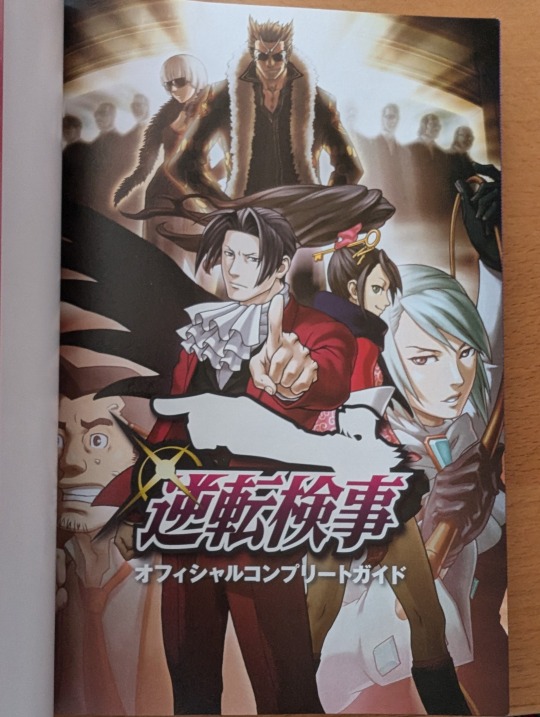
First off, it's gorgeous! And I mean gorgeous! The paper is thick and high quality and the art is wonderfully crisp and vibrant, popping off the pages. It's a lot of fun to just thumb through it and look at all the illustrations.
The different sections are separated by these main character artworks, they're just the official ones for the game but they still look so pretty! (Poor Gumshoe gets shafted though. And I apparently have to correct myself on being confused why Shi-Long got a light green background in the online lottery merch as it looks like he's been associated with that background colour since the beginning. I still don't really think it fits him but oh well.)


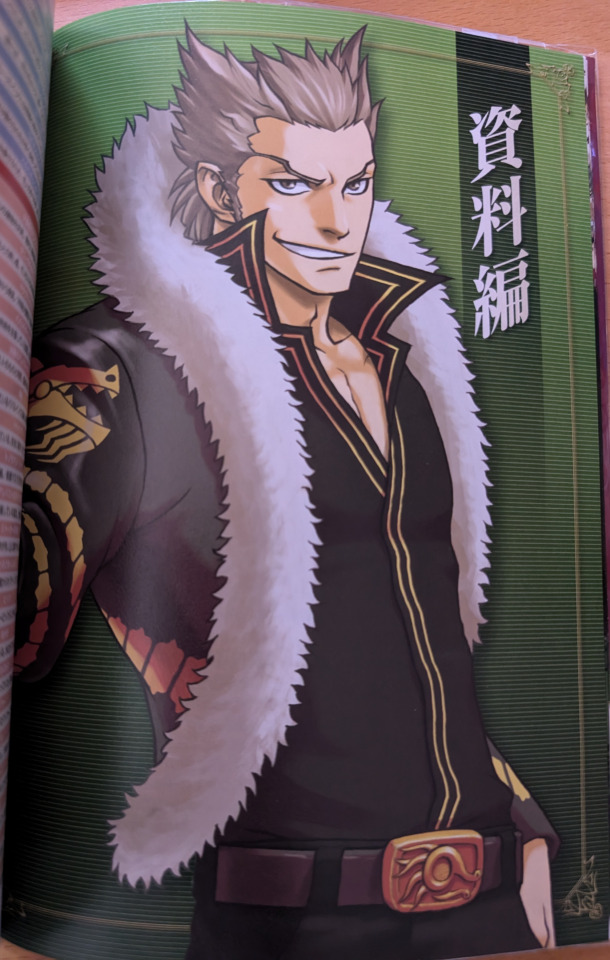
I love the entire presentation of the guide! Even if it's just explaining the general gameplay concept to you (like in the picture below), it's incredibly fancy in how it's presented. For example, the page markings with the characters' faces from the key art, that looks epic! I also love the way the characters are constantly included, interjecting and explaining stuff to you. And with so pretty pictures, too, just look at Shi-Long here!

The guide also includes an entire introduction page for every character (or half a page for the victims), including the large full body illustrations, a short description, their age and height (!), a few pictures of their animations and one of their small sprite. I especially love the large shaded illustrations in the background. So beautiful!

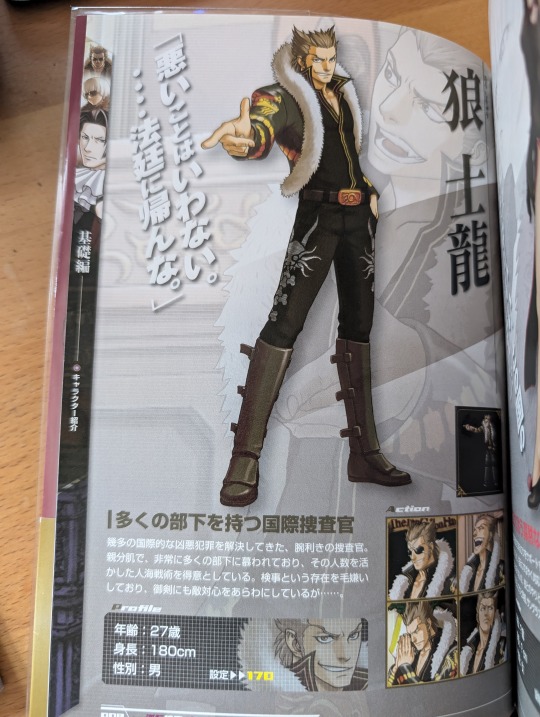

Starting on the individual cases, every case has a character relationship chart at the beginning with all the relevant characters in each case and their relations shown. It's quite interesting how simple they start in the 1st case and how complicated they get by the 5th but also no surprise.

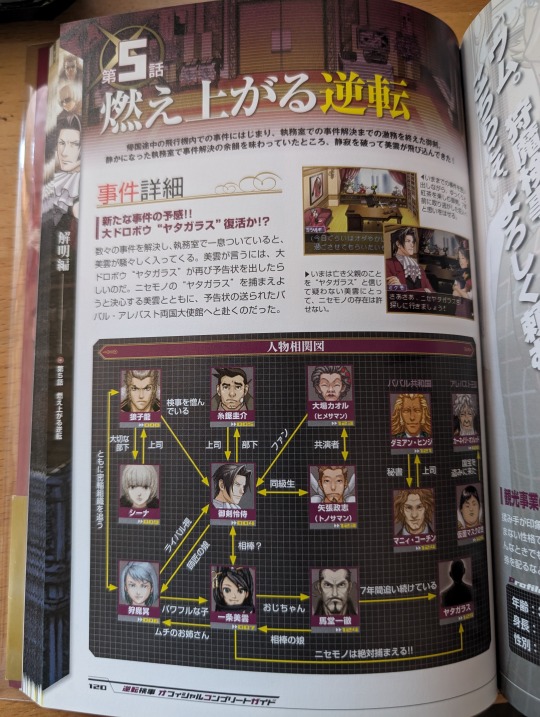
The coverage on the cases goes through every argument, rebuttal and investigation phase throughout the game pointing out the relevant stuff to look at, who to talk to and what to argue about. There are no explicit solutions given but the direction in which to take the argument or what you should think about to get to the answer, Miles often gives an additional hint in a short comment.



Throughout the entire guide Shi-Long provides additional tips and infos about various stuff in these yellow boxes. (Leave it to the top Interpol agent with the highest successful arrest rate to know all the tricks, I guess 😄) Sometimes that's about gameplay mechanics (like how you know when you've investigated everything relevant in an area) but other times it's also explanations for certain concepts that are relevant for the case at hand (like what extraterritorial rights are and the role of an embassy). Shi-Long knows all the stuff!
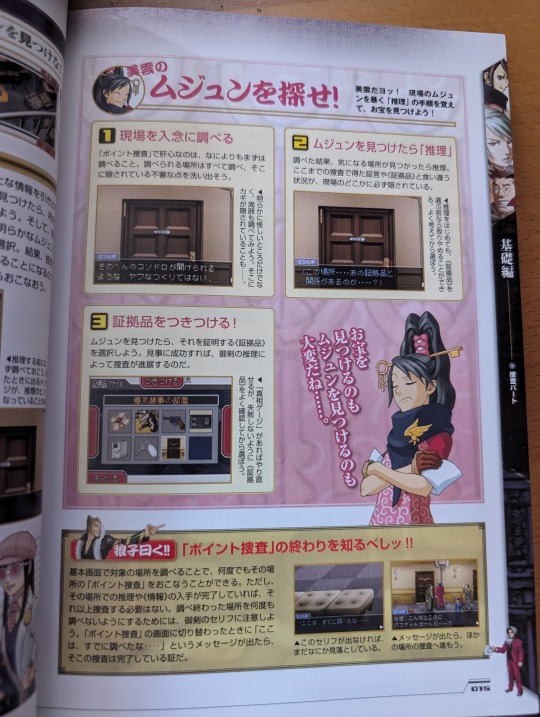

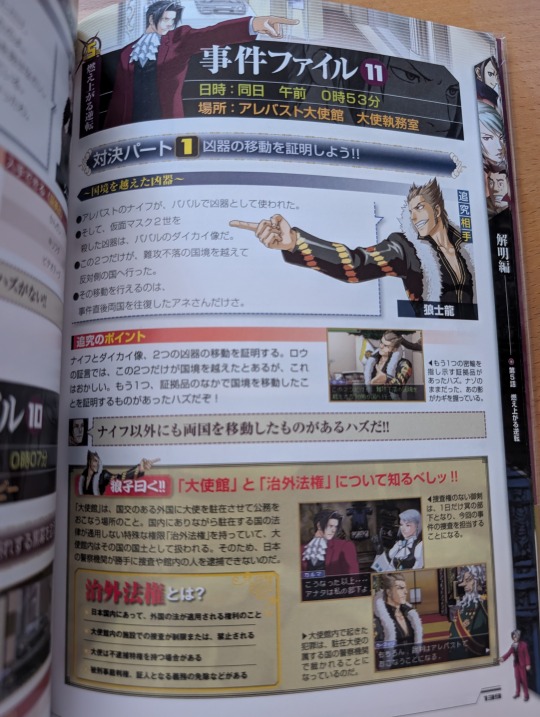
Towards the end there's a section of all the answers and solutions to the rebuttals and investigation phases as a handy flowchart. You can easily recognize it by the large yellow spoiler "WARNING" banners on the page top and bottom. A pretty nice idea to not directly give you all the answers when just going through the guide but should you really be stuck, you can look up what to do here.
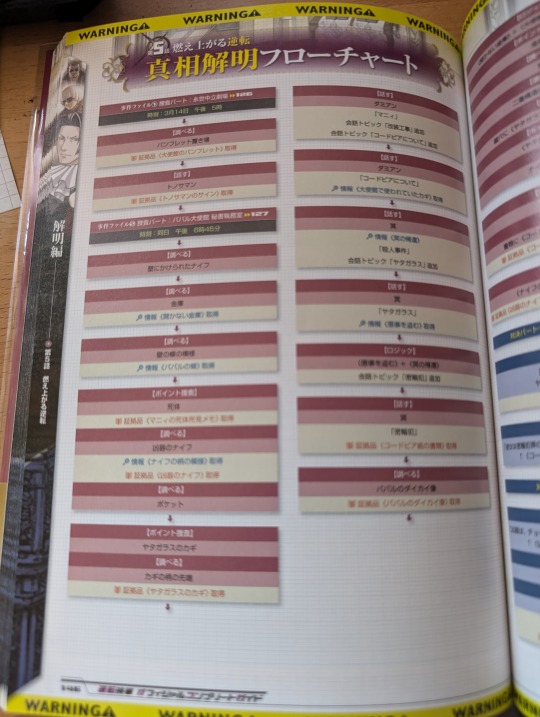
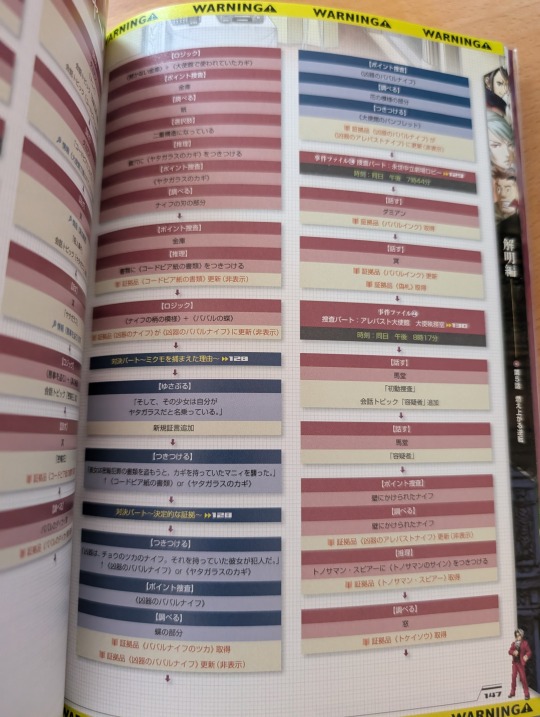
There's also a bunch of concept art, sketches and even some interviews after the cases of the game are done with. They even show some frames of the small sprite animations of various characters. It's in the pixel artstyle, of course, so they're somewhat outdated now with the new HD chibi sprites but I still think they're nice to look at. And all the concept art with the commentaries is amazing! I will definitely go into more detail on those sometime in the future but this post is already more than long enough.
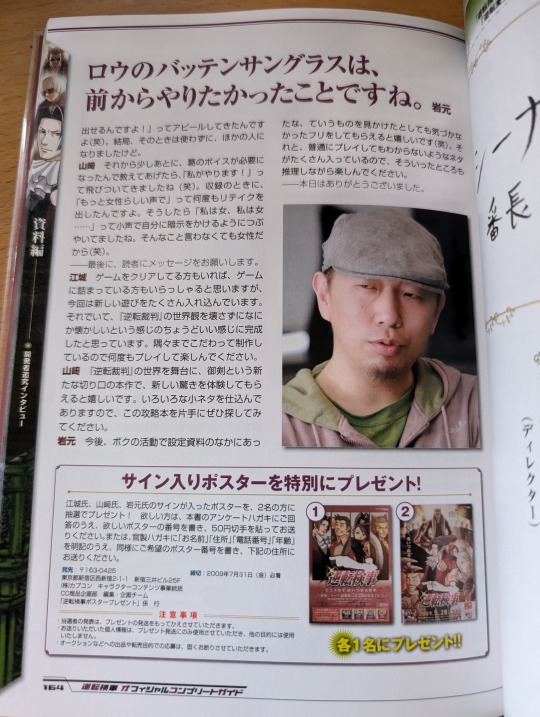
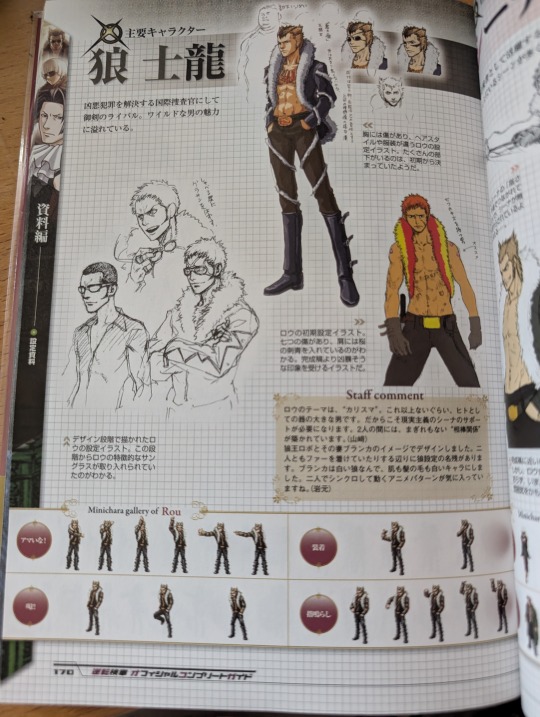

There's even an entire list of all the evidence and all the profiles in the game, separated by case. And one page I found particularly nice (also provided by best agent Shi-Long, of course) is a list of all of the background cameos of previous characters! They don't say the name of the characters outright but they give you more than enough hints that you should be able to tell who they are (if you couldn't before) and I love how they have other characters comment on it.
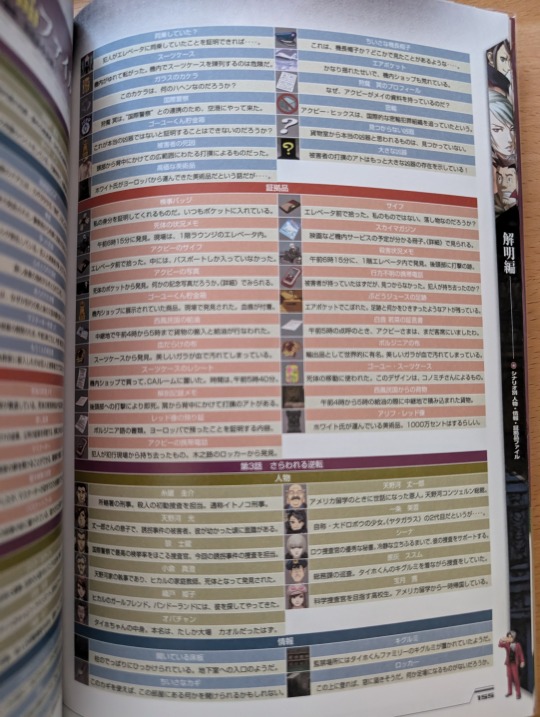
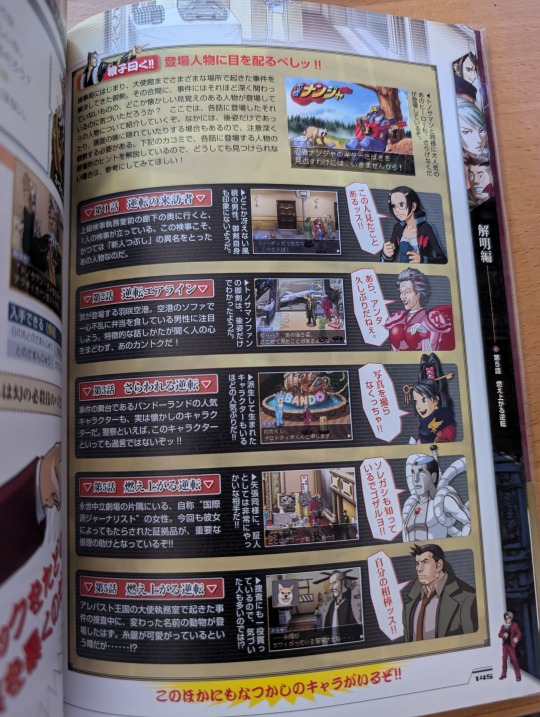
And one last little treat: The bottom corner of every right page has a little Miles sprite on it in different frames of his various animations so that when you flick through the book they "move" like a little flipbook! That's so adorable!
#ace attorney#ace attorney investigations#ace attorney investigations collection#aai collection#ace attorney investigations collection countdown#17 days left
10 notes
·
View notes
Text
I have to say, all the talk about the Japan exclusive gunpla and people not knowing about Gundam because they don't engage with anything produced outside the west have become hilarious in hindsight after the day I've had.
My journey started when I decided I wanted to find out if my local-ish comics/manga/physical media/figurines/etc. store had any gunpla. To be more specific, I was looking for a HG model kit since I'm new to all this and it seems like a good place to start. So I looked around the store and only managed to find a few anime collections(G Gundam, Seed, Seed Destiny, G-Reco, and 00) on my own.
I try to ask one of the people behind the counter if they sell anything related to Gundam. In return I received a thousand-yard stare and that's barely an exaggeration. Keep in mind this person works in a store that sells manga and anime. In fact the main manga section is located right in front of the counter. This was definitely not a case of someone being uncultured but still drew a black at the mention of Gundam. The other person behind the counter had heard of Gundam though but seemed rather exasperated all of a sudden. What I presume to be one internet search later, everyone gets on the same page. I get told to ask the person downstairs about what I'm looking for.
One trip downstairs later I walk to another counter and wait for the person operating it to return. When that happens I'm immediately asked what I'm looking for and I explain that I want to know if they have any Gundam figurines. I once again receive a black expression, though less extreme this time. After a bit of looking around I'm presented with an SD Gunpla. I try, somewhat poorly, to explain what SD is and politely decline.
So far, so absurd.
My next course of action is to look up if there're any stores that sell gunpla within the country I live in. As far as I have been able to find the only place with a decent supply of gunpla a webshop that has only been active since 2019. It's run by this one dude who went to Japan and decided to bring a couple of model kits and might now be the sole provider of gunpla in the country.
This has been the beginning of Sodasa vs gunpla. The kits I'm most interested in turned out to be more affordable than I thought so this journey of mine is most likely far from over.
Also the fact that I would've had a hard time understanding the vocabulary of the Gundam fandom just a few months ago and look at me now. You guys sure got me initiated fast.
13 notes
·
View notes